Lagoonal Microfacies, Lithostratigraphy, Correlation and Shale Migration of the Basal Middle Eocene Seeb Formation (Rusayl Embayment, Sultanate of Oman)
Abstract
:1. Introduction
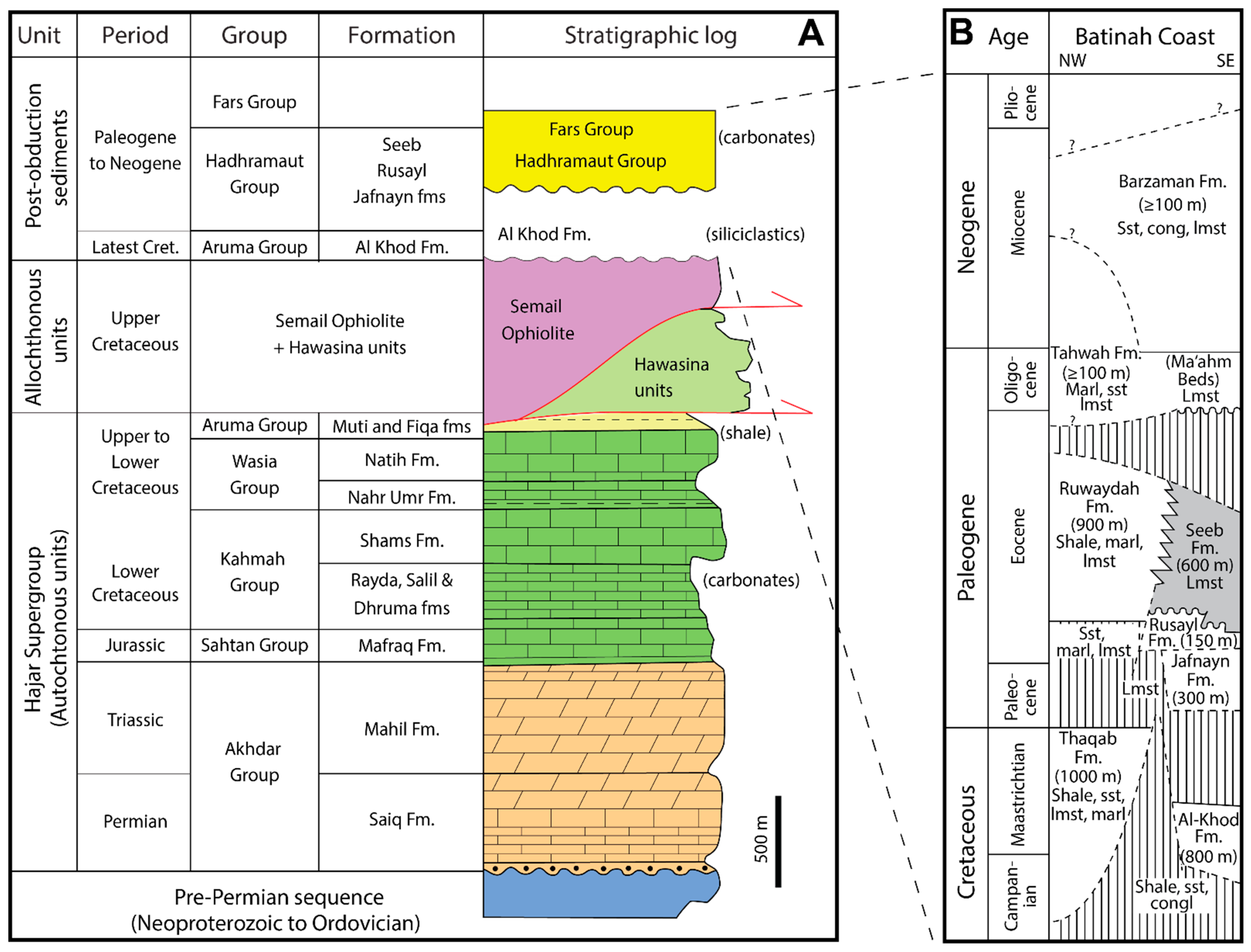
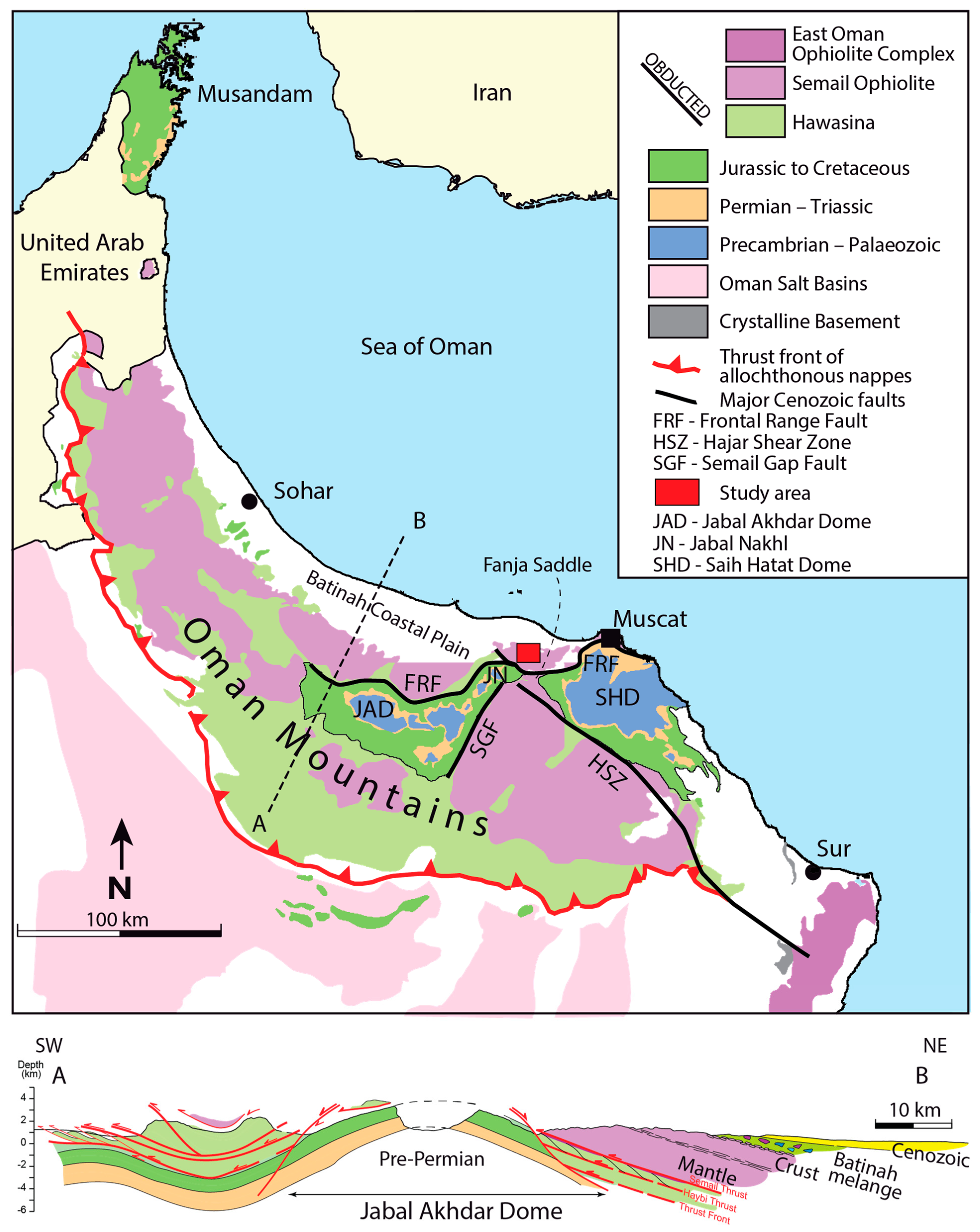

2. Geological Setting
3. Methods
4. Results
4.1. Section 1
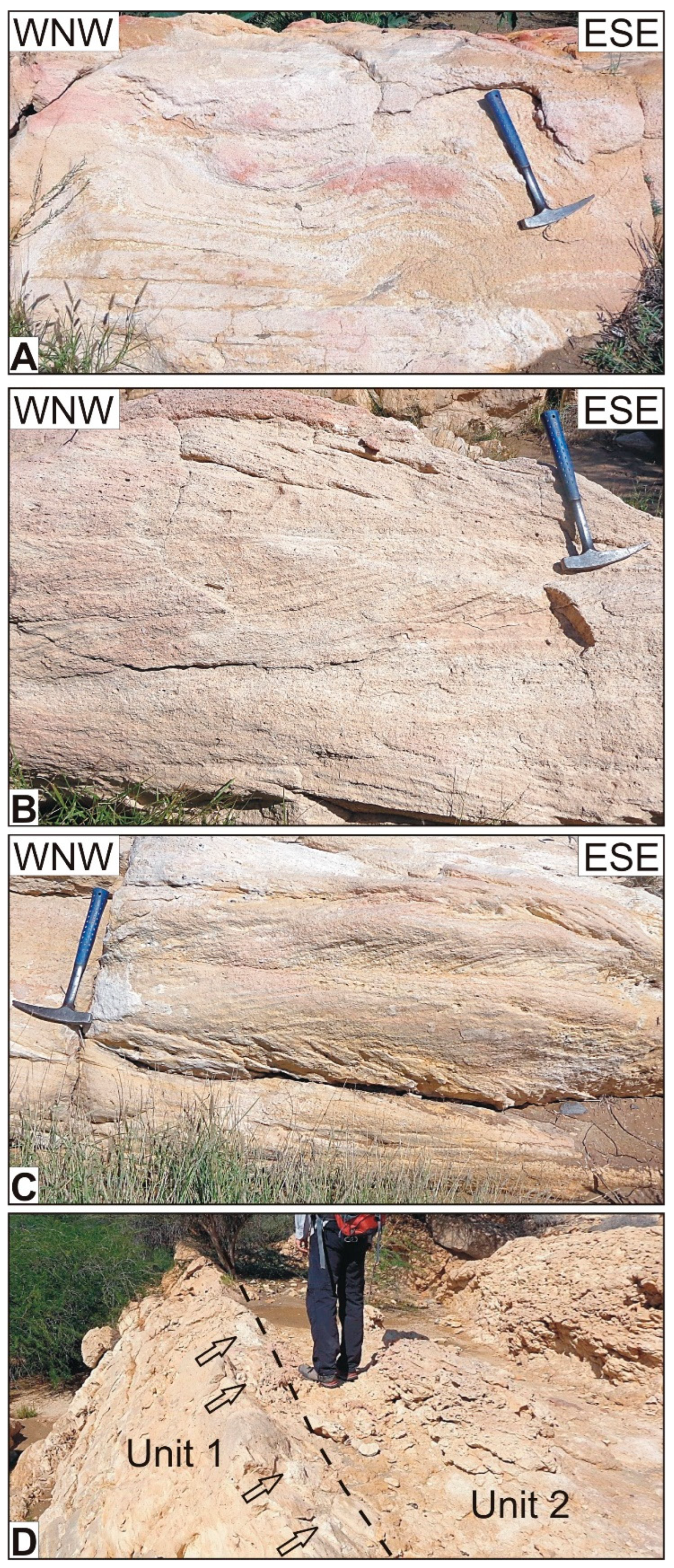
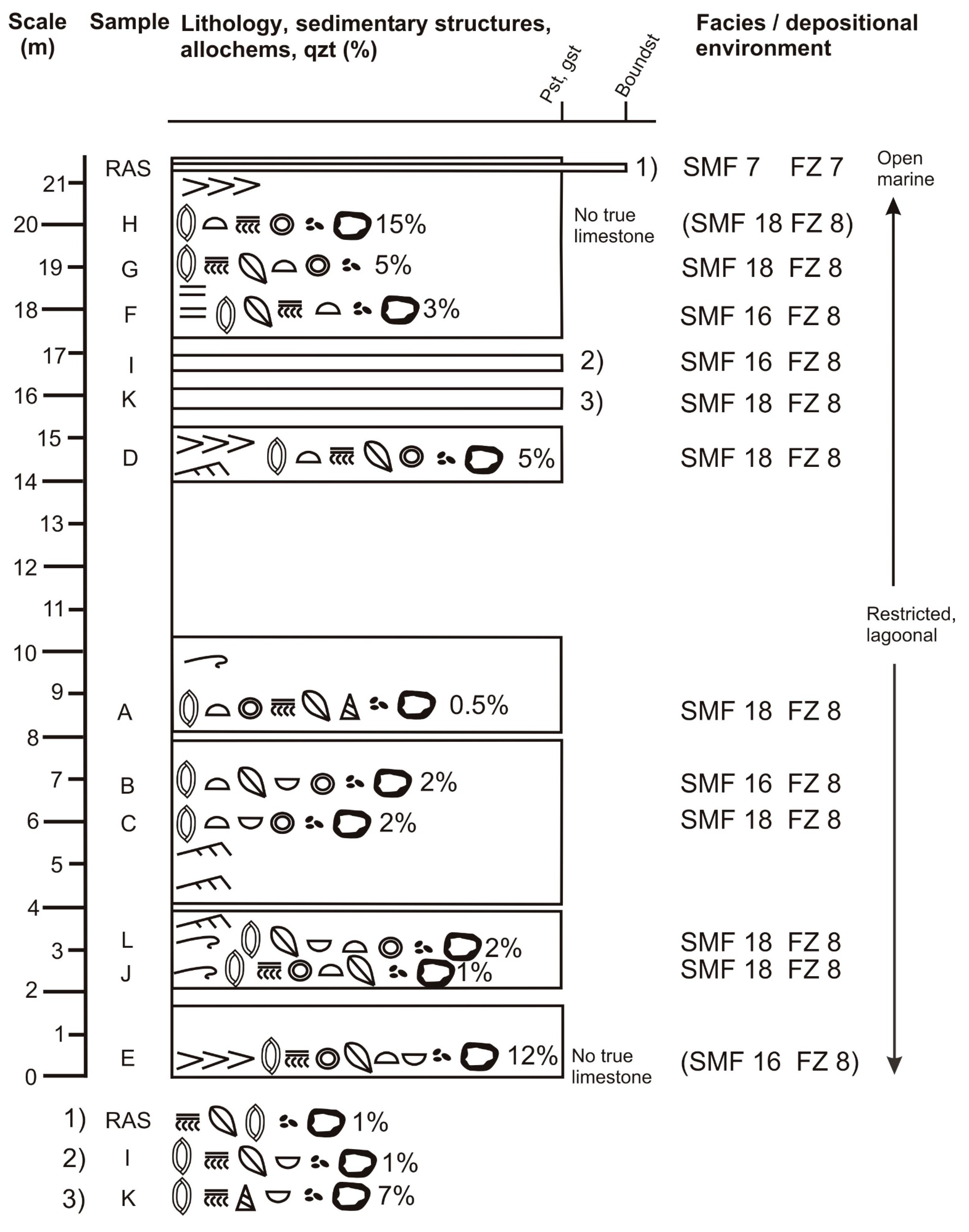

4.2. Gutter Cast Outcrop
4.3. Section 2
4.4. Section 3
4.5. Section 4
4.6. Foraminifera and Age
5. Discussion
5.1. Correlation of Sections
5.2. Limestones and Conglomerates
5.3. Shale Bed
6. Conclusions
Author Contributions
Funding
Acknowledgments
Conflicts of Interest
Appendix A
| Sample | Rock Classification | Contents of Bioclasts, Other Allochems, Detrital Quartz | SMF/FZ |
|---|---|---|---|
| RAS (Top) | Red algae boundstone | Encrusting red algae, few branching red algae > bivalves > benthic foraminifera Some peloids and cortoids 1% of angular very fine to fine quartz sand | SMF 7 FZ 7 |
| H | Foraminiferal pack- to grainstone, if detrital quartz content of >10% is not considered; quartz arenitic limestone (no true limestone) | Benthic foraminifera, including > echinoids, including corona plates and spines > branching red algae and Distychoplax biserialis > dasycladaceans Common peloids, few relatively large cortoids 15% of angular to subrounded fine to medium quartz sand | (SMF 18-FOR FZ 8) |
| G | Foraminiferal pack- to grainstone | Benthic foraminifera > encrusting and branching red algae > bivalves = echinoids, including spines = dasycladaceans Few peloids 5% angular very fine to fine quartz sand | SMF 18-FOR FZ 8 |
| F | Fine-grained peloidal grainstone | Benthic foraminifera > bivalves > branching red algae > echinoid spines Abundant peloids, few relatively large cortoids 3% angular well-sorted very fine quartz sand | SMF 16-NON-LAMINATED FZ 8 |
| I | Fine-grained peloidal grainstone | Benthic foraminifera > branching red algae > echinoids, including spines > bivalves > ostracods Abundant peloids, few cortoids 1% of angular to subrounded very fine to fine quartz sand | SMF 16-NON-LAMINATED FZ 8 |
| K | Fine-grained foraminiferal grainstone | Benthic foraminifera > branching red algae > echinoids, including spines > gastropods = ostracods Some peloids, rare cortoids 7% of subrounded to angular fine to medium quartz sand | SMF 18-FOR FZ 8 |
| D | Foraminiferal grainstone | Benthic foraminifera > echnoids, including spines > branching red algae > bivalves > dasycladaceans Some peloids, rare cortoids 5% of angular to subrounded fine to medium quartz sand | SMF 18-FOR FZ 8 |
| A | Foraminiferal grainstone | Benthic foraminifera > echinoids, including spines > dasycladaceans > branching red algae > bivalves > gastropods Some peloids, rare cortoids <0.5% of angular medium quartz sand | SMF 18-FOR FZ 8 |
| B | Fine-grained peloidal grainstone | Benthic foraminifera > echinoids > bivalves > ostracods > dasycladaceans Abundant peloids, few cortoids 2% angular to subrounded fine to coarse angular (1.3 mm max.) quartz sand; one quartzite clast of 1.1 mm | SMF 16-NON-LAMINATED FZ 8 |
| C | Foraminiferal grainstone | Benthic foraminifera > echnioids, including spines > ostracods > dasycladaceans > Some peloids, few cortoids 2% of subrounded to angular (1 mm max.) fine to coarse quartz sand | SMF 18-FOR FZ 8 |
| L | Fine-grained foraminiferal grainstone | Benthic foraminifera > bivalves > ostracods > echinoids, including spines > dasycladaceans Some peloids, few cortoids 2% of angular very fine to fine quartz sand | SMF 18-FOR FZ 8 |
| J | Foraminiferal grainstone | Benthic foraminifera > branching red algae > dasycladaceans > echinoids > bivalves Few peloids and cortoids 1% of subrounded to angular quartz fine to medium sand | SMF 18-FOR FZ 8 |
| E (Base) | Fine-grained peloidal grainstone, if detrital quartz content of >10% is not considered; quartz arenitic limestone (no true limestone) | Benthic foraminifera > branching red algae > dasycladaceans > bivalves > echinoids, including spine > ostracods Abundant peloids and cortoids 12% subrounded to angular very fine to medium quartz sand | (SMF 16-NON-LAMINATED FZ 8) |
Appendix B
| Sample | Rock Classification | Contents of Bioclasts, Other Allochems, Detrital Quartz | SMF/FZ |
|---|---|---|---|
| 9 (Top) | Laminated foraminiferal grain- to packstone (alternating laminae) | Benthic foraminifera > echinoderms > dasycladaceans > bivalves > ostracods > branching red algae > gastropods Some peloids, few cortoids 1% of angular to subrounded very fine to medium quartz sand | SMF 18-FOR FZ 8 |
| 8 | Peloidal grainstone | Benthic foraminifera > echinoderms > dasycladaceans > red algae = bivalves Abundant peloids, some cortoids 1% of angular to subrounded very fine to medium quartz sand | SMF 16-NON-LAMINATED FZ 8 |
| 1 | Fine-grained peloidal grainstone | Benthic foraminifera > echinoids > ostracods > branching red algae > dasycladaceans > bivalves Abundant peloids, some cortoids 1% angular, very well-sorted very fine quartz sand | SMF 16-NON-LAMINATED FZ 8 |
| 5 | Laminated fine-grained, quartz-bearing peloidal packstone | Echinoids > benthic foraminifera > red algae Abundant peloids, some cortoids 15% angular silt to fine quartz sand | SMF 16-LAMINATED FZ 8 |
| 6 | Foraminiferal grainstone, if detrital quartz content is not considered; quartz arenitic limestone (no true limestone) | Benthic foraminifera > dasycladaceans and other green algae > echinoids > bivalves > gastropods = ostracods Some peloids, cortoids and intraclasts 1% angular well-sorted fine quartz sand | (SMF 18-FOR FZ 8) |
| 3 | Foraminiferal grainstone | Benthic foraminifera > echinoids > red alga Distychoplax biserialis > dasycladaceans = bivalves Some peloids, few cortoids 3% angular fine to medium quartz sand, one 2.2 mm long quartzite granule | SMF 18-FOR FZ 8 |
| 10 | Laminated peloidal packstone to grainstone, if detrital quartz content of >10% is not considered; quartz (no true limestone) arenitic limestone (no true limestone) | Echinoids > benthic foraminifera > dasycladaceans > branching red algae > ostracods Abundant peloids, some cortoids Angular very fine to medium quartz sand up to 20% in certain laminae (overall 15%) | (SMF 16-LAMINATED FZ 8) |
| 4 | Foraminiferal grainstone | Benthic foraminifera > branching red algae > echinoids > bivalves > dasycladaceans > ostracods Some peloids and cortoids 1% of angular very fine to medium quartz sand | SMF 18-FOR FZ 8 |
| 2 (Base) | Laminated foraminiferal grain-to packstone (alternating laminae) | Benthic foraminifera > echinoids > branching red algae and Distychoplax biserialis > dasycladaceans > ostracods Some peloids and cortoids 5% very well-sorted very fine angular quartz sand | SMF 18-FOR FZ 8 |
Appendix C
| Sample | Rock Classification | Contents of Bioclasts, Other Allochems, Detrital Quartz | SMF/FZ |
|---|---|---|---|
| S11 (Top) | Peloidal grainstone | Benthic foraminifera in relatively coarse-grained laminae > echinoid fragments, including spines > dasycladaceans > encrusting and branching red algae > ostracods Abundant peloids, few cortoids 1% of angular to subrounded fine to medium quartz sand | SMF 16-LAMINATED FZ 8 |
| S12 | Peloidal grainstone | Benthic foraminifera > echinoid fragments, including spines > bivalves > dasycladaceans > branching red algae and Distychoplax biserialis > ostracods Common peloids, some cortoids 1% of angular to subrounded fine to medium quartz sand | SMF 16-LAMINATED FZ 8 |
| S8 | Peloidal grainstone | Benthic foraminifera > echinoid fragments > dasycladaceans > bivalves > branching red algae Abundant peloids, some cortoids 5% angular to subrounded fine to medium quartz sand | SMF 16-NON-LAMINATED FZ 8 |
| S10 | Foraminiferal grainstone | Benthic foraminifera > echinoid fragments, including spines > dasycladaceans > ostracods Some peloids, few cortoids; one lamina of peloidal grainstone <1% of angular, well-sorted fine quartz sand | SMF 18-FOR FZ 8 |
| S9 | Foraminiferal grainstone | Benthic foraminifera > echinoid fragments, including corona plates and spines > dasycladaceans > ostracods > gastropods > branching red algae Common peloids, few cortoids 1% of angular to subrounded fine quartz sand | SMF 18-FOR FZ 8 |
| S6 | Partly dolomitized peloidal grainstone | Only few bioclasts; benthic foraminifera > echinoderm fragments > bivalves Abundant peloids, few rare large cortoids 2% of angular to subrounded fine to medium quartz sand | SMF 16-NON-LAMINATED FZ 8 |
| S7 | Mostly dolosparite | Relicts of bioclasts are echinoid fragments, rare micritic-walled red algae and what appear to be micritic-walled foraminifera 5% of angular to subrounded fine to medium quartz sand | No SMF/FZ assigned |
| S17 | Peloidal grainstone | Benthic foraminifera > echinoid fragments, including corona plates and spines > poritid corals > gastropods > dasycladaceans Common peloids, few cortoids 5% angular to subrounded medium to coarse quartz and quartzite sand | SMF 16-NON-LAMINATED FZ 8 |
| S16 | Quartz-foraminiferal rudstone, if detrital quartz content of >10% is not considered (no true limestone) | Benthic foraminifera > echinoid fragments, including corona plates > gastropods > bivalves > dasycladaceans Some large cortoids, few peloids 18% angular to subrounded fine to coarse quartz sand and a few quartzite clasts with lengths <2.5 mm | - |
| S5 | Foraminiferal grainstone (to rudstone) | Benthic foraminifera > echinoid fragments > dasycladaceans > ostracods = poritid corals = branching red algae and Distychoplax biserialis Rare large cortoids 1% angular to subrounded very coarse quartz sand (up to 2 mm), including quartzite fragments with 1.7 mm diameter | SMF 18-FOR FZ 8 |
| S4 | Foraminiferal grainstone | Benthic foraminifera > echinoderm fragments, including corona plates > dasycladaceans > branching red algae Some peloids, few cortoids 3% of angular to subangular medium quartz sand | SMF 18-FOR FZ 8 |
| S3 | Peloidal grainstone | Benthic foraminifera > echinoid fragments, including corona plates and spines > gastropods > bivalves > branching red algae Abundant peloids 5% of angular to subrounded fine to medium quartz sand | SMF 16-LAMINATED FZ 8 |
| S2 | Foraminiferal grainstone (to rudstone) | Benthic foraminifera > echinoid fragments, including corona plates and spines > dasycladaceans > branching red algae Few peloids 2% angular to subrounded quartz fine to medium sand | SMF 18-FOR FZ 8 |
| S13 | Foraminiferal grainstone | Benthic foraminifera > echnoid fragments, including corona plates and spines > gastropods > dasycladaceans > branching read algae > ostracods Some peloids, few cortoids 2% subrounded to angular fine to coarse quartz sand | SMF 18-FOR FZ 8 |
| S1 (Base) | Laminated foraminiferal grainstone | Benthic foraminifera > echinoids, including corona plate fragments and spines > ostracods > bryozoans = bivalves > red algae, including Distychoplax biserialis Some peloids 3% angular to subrounded fine to coarse quartz sand | SMF 18-FOR FZ 8 |
Appendix D
| Sample | Rock Classification | Contents of Bioclasts, Other Allochems, Detrital Quartz | SMF/FZ |
|---|---|---|---|
| AF22 (Top) | Partly dolomitized foraminiferal grainstone | Benthic micritic foraminifera and ghosts of foraminifera > corals > echnioids, including spines > branching red algae > ostracods Common peloids, few cortoids, two mainly calciclastic lithoclasts with angular medium quartz sand 4% angular to subangular fine to medium quartz sand | SMF 18-FOR FZ 8 |
| AF21 | Peloidal grainstone | Benthic foraminifera > echinoids, including spines Common peloids 7% subangular to subrounded very fine to medium quartz sand | SMF 16-NON-LAMINATED FZ 8 |
| AF20 | Peloidal grainstone | Benthic foraminifera > echinoids, including spines > bivalves > Distychoplax biserialis Common peloids 7% subangular to subrounded very fine to coarse quartz sand | SMF 16-NON-LAMINATED FZ 8 |
| AF18 | Foraminiferal grainstone; parallel orientation of bladed and elongate grains | Benthic foraminifera > echinoids, including spines > dasycladaceans Common peloids, some cortoids 2% subangular to subrounded very fine to very coarse quartz sand | SMF 18-FOR FZ 8 |
| AF17 | Peloidal grainstone | Benthic foraminifera > echinoids, including spines > encrusting and branching red algae > ostracods Abundant peloids, few large cortoids 2% subangular to subrounded very fine to medium quartz sand | SMF 16-LAMINATED FZ 8 |
| AF16 | Peloidal grainstone | Benthic foraminifera > echinoids, including spines > ostracods Abundant peloids, common cortoids (some large) | SMF 16-NON-LAMINATED FZ 8 |
| AF15 | Calcitic dolosparite with small dolomite crystals; developed from foraminifer grainstone | Benthic foraminifera (mainly with micritic tests) > echinoids > red algae Few large cortoids | SMF 18-FOR FZ 8 |
| AF14 | Peloidal grainstone | Rare echinoids Abundant peloids, some cortoids 1–2% angular to subrounded very fine to fine quartz sand | SMF 16-NON-LAMINATED FZ 8 |
| AF13 | Foraminiferal grainstone | Benthic foraminifera > echinoids, including spines > dasycladaceans > encrusting red algae Common peloids, some cortoids, rare intraclasts 5% subangular to subrounded medium to very coarse quartz/quartzite sand | SMF 18-FOR FZ 8 |
| AF12 | Porous, poorly cemented quartz-rich litharenite; cement is opaque material | 90% very fine to very coarse quartz sand; lithics: quartzite, muscovite-quartz aggregates, chert | - |
| AF11 | Peloidal grainstone; elongate grains are parallel, forming preferred orientation | Benthic foraminifera > echinoids, including spines > dasycladaceans > gastropods > ostracods Abundant peloids 5% angular to subrounded fine sand to granule-sized quartz grains which may be polycrystalline | SMF 16-NON-LAMINATED FZ 8 |
| AF10 | Peloidal grainstone | Benthic foraminifera > echinoids, including spines Abundant peloids, rare large cortoids 2% of very fine to medium angular to subangular quartz sand | SMF 16-NON-LAMINATED FZ 8 |
| AF9 | Peloidal grainstone | Echinoids, including spines > benthic foraminifera > dasycladaceans > ostracods Common peloids (including pellets?) 1–2% of angular very fine to fine angular to subangular quartz sand | SMF 16-NON-LAMINATED FZ 8 |
| AF8 | Locally dolomitized, foraminiferal biosparite; only few grain contacts | Benthic foraminifera = echinoids, including corona plates > branching red algae > dasycladaceans Few peloids, rare large cortoids 3–4% angular to subrounded very fine to medium quartz sand | - |
| AF7 | Foraminiferal grainstone | Benthic foraminifera > echinoids, including corona plates > dasycladaceans > bivalves > gastropods > branching red algae > ostracods Few peloids | SMF 18-FOR FZ 8 |
| AF6 | Foraminiferal grainstone; in the field locally identified as rudstone | Benthic foraminifera, often flat, thin and disk-shaped > echinoids, including corona plates and test of sand dollar > dasycladaceans > branching red algae | SMF 18-FOR FZ 8 |
| AF5 | Foraminiferal grainstone from a debrite | Benthic foraminifera > echinoids, including corona plates > dasycladaceans > bivalves > gastropods Few peloids 2% angular to subrounded very fine to fine quartz sand | SMF 18-FOR FZ 8 |
| AF4 | Foraminiferal grainstone; parallel orientation of bladed and elongate grains | Benthic foraminifera > echinoids, including corona plates and spines > dasycladaceans > bivalves Few peloids, few large cortoids 3% angular to subrounded fine quartz sand | SMF 18-FOR FZ 8 |
| AF3 | Matrix-supported biosparite; no grain contacts | Benthic foraminifera > echinoids, including test and spines > bivalves > dasycladaceans > branching red algae > gastropods > ostracods Few peloids, few large cortoids 3% angular to subangular very fine to fine quartz sand | - |
| AF2 | Slightly dolomitized foraminiferal grainstone | Benthic foraminifera > branching red algae > echinoids, including corona plate > dasycladaceans = bivalves Some peloids, few large cortoids 1–2% of angular to subrounded very fine to fine quartz sand | SMF 18-FOR FZ 8 |
| AF1 (Base) | Slightly dolomitized foraminiferal wackestone possibly slumped and/or bored | Benthic foraminifera > gastropods > bivalves > dasycladaceans > branching red algae Some peloids | - |
Appendix E
| Ref. Code | Chemical Formula | Mineral Name | Wt% |
| 98-015-6196 | SiO2 | Quartz | 30 |
| 98-006-8698 | Al2Si2O5(OH)4 | Kaolinite | 70 |
| Pos. [°2Th.] | Height [cts] | FWHM Left [°2Th.] | d-Spacing [Å] | Rel. Int. [%] |
| 5.8591 | 104.88 | 0.6691 | 15.08452 | 3.42 |
| 12.3136 | 763.43 | 0.2342 | 7.18826 | 24.86 |
| 19.8315 | 722.97 | 0.2342 | 4.47698 | 23.55 |
| 20.8490 | 979.14 | 0.1004 | 4.26074 | 31.89 |
| 24.8411 | 476.85 | 0.2676 | 3.58433 | 15.53 |
| 26.6058 | 3070.43 | 0.1338 | 3.35046 | 100.00 |
| 33.1089 | 117.60 | 0.2676 | 2.70574 | 3.83 |
| 34.9313 | 304.11 | 0.2676 | 2.56864 | 9.90 |
| 35.8785 | 240.22 | 0.2676 | 2.50297 | 7.82 |
| 36.5170 | 206.43 | 0.1338 | 2.46066 | 6.72 |
| 38.5709 | 192.91 | 0.3011 | 2.33423 | 6.28 |
| 39.4121 | 149.18 | 0.1338 | 2.28633 | 4.86 |
| 40.2648 | 61.94 | 0.1673 | 2.23985 | 2.02 |
| 42.4104 | 135.54 | 0.1171 | 2.13137 | 4.41 |
| 45.7751 | 116.49 | 0.2007 | 1.98223 | 3.79 |
| 47.9358 | 41.44 | 0.2007 | 1.89781 | 1.35 |
| 50.0990 | 244.37 | 0.0836 | 1.82082 | 7.96 |
| 54.0590 | 102.43 | 0.5353 | 1.69642 | 3.34 |
| 54.9112 | 143.69 | 0.2007 | 1.67209 | 4.68 |
| 59.9179 | 160.77 | 0.1338 | 1.54379 | 5.24 |
| 62.2939 | 218.53 | 0.4015 | 1.49050 | 7.12 |
| 64.0282 | 68.57 | 0.3346 | 1.45425 | 2.23 |
| 67.6923 | 108.46 | 0.1004 | 1.38418 | 3.53 |
| 68.1186 | 144.58 | 0.1338 | 1.37655 | 4.71 |
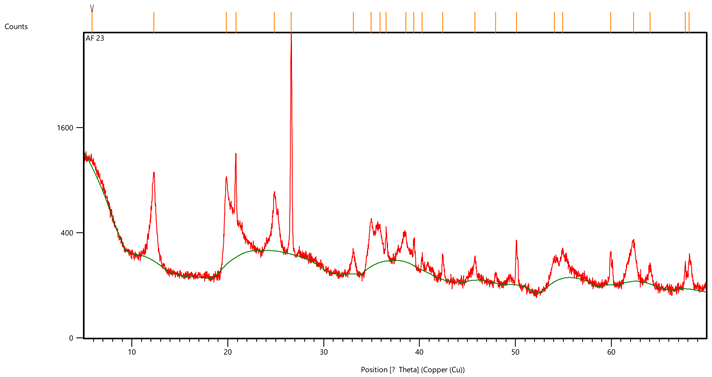
Appendix F
| Ref. Code | Chemical Formula | Mineral Name | Wt% |
| 98-008-3849 | SiO2 | Quartz | 30 |
| 98-015-1692 | CaSO4·2H2O | Gypsum | 45 |
| 98-006-8698 | Al2Si2O5(OH)4 | Kaolinite | 25 |
| Pos. [°2Th.] | Height [cts] | FWHM Left [°2Th.] | d-Spacing [Å] | Rel. Int. [%] |
| 11.5873 | 5848.54 | 0.1171 | 7.63710 | 100.00 |
| 11.7209 | 5188.75 | 0.0836 | 7.55034 | 88.72 |
| 12.3535 | 468.51 | 0.3011 | 7.16511 | 8.01 |
| 19.9105 | 359.62 | 0.3680 | 4.45940 | 6.15 |
| 20.8157 | 1429.30 | 0.1338 | 4.26748 | 24.44 |
| 23.4614 | 855.02 | 0.1171 | 3.79189 | 14.62 |
| 24.9063 | 250.29 | 0.2342 | 3.57509 | 4.28 |
| 26.5614 | 2236.08 | 0.0502 | 3.35595 | 38.23 |
| 26.7157 | 2895.81 | 0.0502 | 3.33692 | 49.51 |
| 29.1278 | 969.65 | 0.2175 | 3.06585 | 16.58 |
| 31.1332 | 344.10 | 0.1171 | 2.87279 | 5.88 |
| 32.1121 | 53.01 | 0.2007 | 2.78741 | 0.91 |
| 33.4179 | 366.67 | 0.2007 | 2.68143 | 6.27 |
| 34.9931 | 139.94 | 0.2676 | 2.56425 | 2.39 |
| 35.6026 | 173.75 | 0.3346 | 2.52173 | 2.97 |
| 36.0056 | 152.29 | 0.2007 | 2.49443 | 2.60 |
| 36.5950 | 300.24 | 0.2007 | 2.45560 | 5.13 |
| 38.4998 | 65.31 | 0.4015 | 2.33837 | 1.12 |
| 39.5183 | 221.50 | 0.0502 | 2.28043 | 3.79 |
| 40.7134 | 187.70 | 0.1338 | 2.21620 | 3.21 |
| 42.3806 | 113.60 | 0.2342 | 2.13280 | 1.94 |
| 43.3567 | 101.81 | 0.2007 | 2.08702 | 1.74 |
| 44.2390 | 33.89 | 0.2007 | 2.04743 | 0.58 |
| 45.8506 | 77.63 | 0.4684 | 1.97914 | 1.33 |
| 47.8629 | 217.28 | 0.2342 | 1.90053 | 3.72 |
| 48.4222 | 116.39 | 0.2007 | 1.87988 | 1.99 |
| 50.1857 | 247.69 | 0.1004 | 1.81788 | 4.24 |
| 51.3475 | 91.70 | 0.2007 | 1.77944 | 1.57 |
| 53.8849 | 42.65 | 0.5353 | 1.70149 | 0.73 |
| 54.8889 | 101.91 | 0.2676 | 1.67272 | 1.74 |
| 56.8095 | 90.35 | 0.2676 | 1.62065 | 1.54 |
| 60.0097 | 152.36 | 0.2007 | 1.54165 | 2.61 |
| 62.3981 | 111.84 | 0.4684 | 1.48826 | 1.91 |
| 64.0828 | 93.21 | 0.2007 | 1.45314 | 1.59 |
| 67.7566 | 83.94 | 0.1338 | 1.38302 | 1.44 |
| 68.1690 | 148.15 | 0.1338 | 1.37565 | 2.53 |

Appendix G
| Ref. Code | Chemical Formula | Mineral Name | Wt% |
| 98-002-7826 | SiO2 | Quartz | 40 |
| 98-006-3316 | Al2Si2O5(OH)4 | Kaolinite | 60 |
| Pos. [°2Th.] | Height [cts] | FWHM Left [°2Th.] | d-Spacing [Å] | Rel. Int. [%] |
| 6.1646 | 313.51 | 0.5353 | 14.33751 | 5.34 |
| 7.1453 | 262.93 | 0.5353 | 12.37178 | 4.47 |
| 12.3956 | 684.43 | 0.2676 | 7.14086 | 11.65 |
| 19.9311 | 646.21 | 0.3346 | 4.45485 | 11.00 |
| 20.9094 | 1337.67 | 0.1338 | 4.24858 | 22.77 |
| 24.9880 | 438.33 | 0.2676 | 3.56359 | 7.46 |
| 26.7100 | 5875.77 | 0.1506 | 3.33762 | 100.00 |
| 33.2280 | 54.04 | 0.5353 | 2.69632 | 0.92 |
| 35.0156 | 248.20 | 0.2007 | 2.56265 | 4.22 |
| 35.7300 | 220.21 | 0.3346 | 2.51303 | 3.75 |
| 36.6131 | 389.29 | 0.1004 | 2.45442 | 6.63 |
| 38.4790 | 170.79 | 0.2342 | 2.33959 | 2.91 |
| 39.5336 | 240.54 | 0.2007 | 2.27958 | 4.09 |
| 40.3574 | 154.89 | 0.1338 | 2.23493 | 2.64 |
| 42.5082 | 161.29 | 0.2007 | 2.12669 | 2.75 |
| 45.8392 | 157.18 | 0.1673 | 1.97961 | 2.68 |
| 48.0605 | 43.86 | 0.2007 | 1.89317 | 0.75 |
| 50.1578 | 415.08 | 0.1004 | 1.81882 | 7.06 |
| 54.9453 | 284.68 | 0.0612 | 1.66975 | 4.84 |
| 59.9850 | 299.44 | 0.1004 | 1.54222 | 5.10 |
| 62.3391 | 185.47 | 0.4015 | 1.48952 | 3.16 |
| 64.0834 | 103.17 | 0.3346 | 1.45313 | 1.76 |
| 67.7775 | 182.69 | 0.1338 | 1.38264 | 3.11 |
| 68.1994 | 215.99 | 0.1338 | 1.37512 | 3.68 |
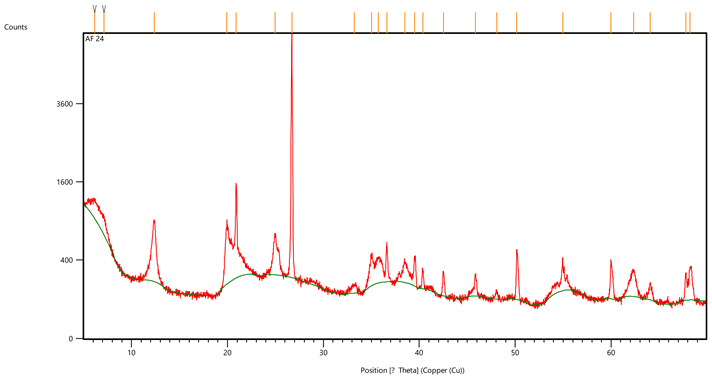
References
- Nolan, S.C.; Skelton, P.W.; Clissold, B.P.; Smewing, J.D. Maastrichtian to Early Tertiary stratigraphy and paleogeography of the Central and Northern Oman Mountains. In The Geology and Tectonics of the Oman Region; Robertson, A.H.F., Ries, M.P., Ries, A.C., Eds.; Geological Society: London, UK, 1990; Volume 49, pp. 495–519. [Google Scholar]
- Jones, R.W.; Racey, A. Cenozoic stratigraphy of the Arabian Peninsula and Gulf. In Micropaleontology and Hydrocarbon Exploration in the Middle East; Simmons, M.D., Ed.; Chapman & Hall: London, UK, 1994; pp. 273–307. [Google Scholar]
- Racey, A. Lithostratigraphy and larger foraminiferal (nummulitid) biostratigraphy of the Tertiary of northern Oman. Micropaleont. 1995, 41, 1–123. [Google Scholar] [CrossRef]
- Schaub, H. Nummulites et Assilines de la Tethys paleogene, taxinomie, phylogenie et biostratigraphie avec deux volumes d’atlas. Schweiz. Paläont. Abh. 1981, 104–106, 236. [Google Scholar]
- Cohen, K.M.; Finney, S.; Gibbard, P.L. International Chronostratoigraphic Chart (International Commission on Stratigraphy). Episodes 2013, 36, 199–204. [Google Scholar] [CrossRef] [PubMed]
- Béchennec, F.; Roger, J.; Le Métour, J.; Wyns, R. Geological Map of Seeb, Sheet NF 40-03, 1:250,000 with Explanatory Notes; Ministry of Petroleum and Minerals: Muscat, Oman, 1992. [Google Scholar]
- Beavington-Penney, S.J.; Wright, V.P.; Racey, A. The Middle Eocene Seeb Formation of Oman: An investigation of acyclicity, stratigraphic completeness, and accumulation rates in shallow marine carbonate settings. J. Sediment. Res. 2006, 76, 1137–1161. [Google Scholar] [CrossRef]
- Hersi, O.S.; Al-Harthy, A. Lithofacies attributes of a transgressive carbonate system: The middle Eocene Seeb formation, Al Khoudh area, Muscat, Oman. SQU J. Sci. 2010, 15, 41–54. [Google Scholar] [CrossRef]
- Pickford, M. Late Cretaceous Lanistes (Mollusca, Gastropoda) from Al-Khod, Oman. Al-Hajar 2017, 23, 15–29. [Google Scholar]
- Mattern, F.; Al-Sayigh, A.R.; Farfour, M.; Scharf, A.; Al-Amri, S.; Al-Omairi, J. Microfacies, Biostratigraphy, Depositional Environment, Seismic Refraction and Correlation of Coralline Limestones of the Barzaman Formation (Oligocene-Pliocene? Al-Khod, Muscat Area, Oman). SQU J. Sci. 2020, 25, 85–99. [Google Scholar]
- Callegari, I.; Scharf, A.; Mattern, F.; Scharf, K. Tectonic transition from thrusting to polyphase non-confining deformation within the Semail Ophiolite along the sinistral, transtensional Issmaiya Fault Zone (Sulatanate of Oman). J. Asian Earth Sci. 2021, 224, 105007. [Google Scholar] [CrossRef]
- Mattern, F.; Scharf, A. Postobductional extension along and within the Frontal Range of the Eastern Oman Mountains. J. Asian Earth Sci. 2018, 154, 369–385. [Google Scholar] [CrossRef]
- Scharf, A.; Mattern, F.; Moraetis, D.; Callegari, I.; Weidle, C. Postobductional Kinematic Evolution and Geomorphology of a Major Regional Structure—The Semail Gap Fault Zone (Oman Mountains). Tectonics 2019, 38, 2756–2778. [Google Scholar] [CrossRef]
- Scharf, A.; Mattern, F.; Bolhar, R.; Callegari, I.; Ring, U. Oligocene/early Miocene E/W-shortening in the Oman Mountains related to oblique Arabia-India convergence. Tectonics 2022, 41, e2022TC007271. [Google Scholar] [CrossRef]
- Searle, M.P. Structural geometry, style and timing of deformation in the Hawasina window, Al Jabal al Akhdar and Saih Hatat culminations, Oman mountains. GeoArabia 2007, 12, 99–130. [Google Scholar] [CrossRef]
- Racey, A. A review of Eocene nummulitide accumulations: Structure, formation and reservoir potential. J. Petrol. Geol. 2001, 24, 79–100. [Google Scholar] [CrossRef]
- Dill, H.G.; Wehner, H.; Kus, J.; Botz, R.; Berner, Z.; Stüben, D.; Al-Sayigh, A. The Eocene Rusayl Formation, Oman, carbonaceous rocks in calcareous shelf sediments: Environment of deposition, alteration and hydrocarbon potential. Int. J. Coal Geol. 2007, 72, 89–123. [Google Scholar] [CrossRef]
- Flügel, E. Microfacies of Carbonate Rocks, Analysis, Interpretation and Application, 2nd ed.; Springer: Berlin/Heidelberg, Germany, 2010; p. 984. [Google Scholar]
- Haq, B.U.; Hardenbol, J.; Vail, P.R.; Wright, R.C.; Stover, L.E.; Baum, G.; Loutit, T.; Gombos, A.; Davies, T.; Pflum, C.; et al. Mesozoic-Cenozoic cycle chart. In Sea-Level Changes: An Integrated Approach; Wilgus, C.K., Hastings, B.S., Kendall, C.G.S., Posamentier, H.W., Ross, C.A., Van Wagoner, J.C., Eds.; SEPM: Tulsa, OK, USA, 1988. [Google Scholar]
- Glennie, K.W.; Boeuf, M.G.A.; Hughes-Clarke, M.W.; Moody-Stuart, M.; Pilaar, W.F.H.; Reinhardt, B.M. Late Cretaceous nappes in Oman Mountains and their geological evolution. Am. Assoc. Petrol. Geol. Bull. 1973, 57, 5–27. [Google Scholar]
- Glennie, K.W.; Boeuf, M.G.A.; Hughes Clarke, M.W.; Moody-Stuart, M.; Pilaar, W.; Reinhardt, B.M. Geology of the Oman Mountains. Verh. K. Ned. Geol. Mijnbouwkd. Genoot. 1974, 31, 1–423. [Google Scholar] [CrossRef]
- Searle, M.P.; Malpas, J. Structure and metamorphism of rocks beneath the Semail ophiolite of Oman and their significance in ophiolite obduction. Trans. R. Soc. Edinb. 1980, 71, 247–262. [Google Scholar] [CrossRef]
- Lippard, S.J.; Shelton, A.W.; Gass, I.G. The ophiolite of northern Oman. Geol. Soc. Mem. 1986, 11, 1–178. [Google Scholar]
- Goffé, B.; Michard, A.; Kienast, J.R.; LeMer, O. A case of obduction related high P, low T metamorphism in upper crustal nappes, Arabian continental margin, Oman: P-T paths and kinematic interpretation. Tectonophysics 1988, 151, 363–386. [Google Scholar] [CrossRef]
- Rollinson, H.R.; Searle, M.P.; Abbasi, I.A.; Al-Lazki, A.I.; Al Kindi, M.H. (Eds.) Introduction. In Tectonic Evolution of the Oman Mountains; Geological Society: London UK, 2014; Volume 392, pp. 27–37. [Google Scholar]
- Searle, M.; Cox, J. Tectonic setting, origin, and obduction of the Oman ophiolite. Geol. Soc. Am. Bull. 1991, 111, 104–122. [Google Scholar] [CrossRef]
- Hacker, B.R.; Mosenfelder, J.L.; Gnos, E. Rapid emplacement of the Oman ophiolite: Thermal and geochronologic constraints. Tectonics 1996, 15, 1230–1247. [Google Scholar] [CrossRef]
- Glennie, K.W. The Geology of the Oman Mountains: An Outline of Their Origin, 2nd ed.; Scientific Press: Beaconsfield, UK, 2005; p. 110. [Google Scholar]
- Scharf, A.; Mattern, F.; Al-Wardi, M.; Frijia, G.; Moraetis, D.; Pracejus, B.; Bauer, W.; Callegari, I. The Geology and Tectonics of the Jabal Akhdar and Saih Hatat Domes, Oman Mountains; Geological Society: London, UK, 2021; Volume 54, p. 124. [Google Scholar]
- Al-Wardi, M.; Butler, R.W.H. Constrictional extensional tectonics in the northern Oman mountains, its role in culmination development and the exhumation of the subducted Arabian continental margin. In Deformation of the Continental Crust: The Legacy of Mike Coward; Ries, A.C., Butler, R.W.H., Graham, R.H., Eds.; Geological Society: London, UK, 2007; Volume 272, pp. 187–202. [Google Scholar]
- Scharf, A.; Bailey, C.M.; Bolhar, R.; Mattern, F.; Ring, U. Post-obduction listwaenite genesis in the Oman Mountains inferred from structural analysis and U-Pb carbonate dating. Earth Planet. Sci. Lett. 2022, 595, 117756. [Google Scholar] [CrossRef]
- Coffield, D.Q. Structures associated with nappe emplacement and culmination collapse in the Central Oman Mountains. In The Geology and Tectonics of the Oman Region; Robertson, A.H.F., Ries, M.P., Ries, A.C., Eds.; Geological Society: London, UK, 1990; Volume 49, pp. 4547–4548. [Google Scholar]
- Poupeau, G.; Saddiqi, O.; Goffé, A.M.B.; Oberhänsli, R. Late thermal evolution of the Oman Mountains subophiolitic windows: Apatite fission-track thermochronology. Geology 1998, 26, 1139–1142. [Google Scholar] [CrossRef]
- Saddiqi, O.; Michard, A.; Goffé, B.; Poupeau, G.; Oberhänsli, R. Fission-track thermochronology of the Oman Mountains continental windows, and current problems of interpretation. Bull. Soc. Géol. Fr. 2006, 177, 127–134. [Google Scholar] [CrossRef]
- Grobe, A.; Virgo, S.; von Hagke, C.; Urai, J.L.; Littke, R. Multiphase Structural Evolution of a Continental Margin during Obduction Orogeny: Insights from the Jebel Akhdar Dome, Oman Mountains. Tectonics 2018, 37, 888–913. [Google Scholar] [CrossRef]
- Grobe, A.; van Hagke, C.; Littke, R.; Dunkl, I.; Wübbeler, F.; Muchez, P.; Urai, J.L. Tectono-thermal evolution of Oman’s Mesozoic passive continental margin under the obducting Semail Ophiolite: A case study of Jebel Akhdar, Oman. Solid Earth 2019, 10, 149–175. [Google Scholar] [CrossRef]
- Hansman, R.J.; Ring, U.; Thomson, S.N.; den Brock, B.; Stübner, K. Late Eocene uplift of the Al Hajar Mountains, Oman, supported by stratigraphic and low-temperature thermochronology. Tectonics 2017, 36, 3081–3109. [Google Scholar] [CrossRef]
- Scharf, A.; Sudo, M.; Pracejus, B.; Mattern, F.; Callegari, I.; Bauer, W.; Scharf, K. Late Lutetian (Eocene) mafic intrusion into shallow marine platform deposits north of the Oman Mountains (Rusayl Embayment) and its tectonic significance. J. Afr. Earth Sci. 2020, 170, 103941. [Google Scholar] [CrossRef]
- Abbasi, I.A.; Hersi, O.S.; Al-Harty, A. Late Cretaceous conglomerates of the Qahlah Formation, north Oman. In Tectonic Evolution of the Oman Mountains; Rollinson, H.R., Searle, M.P., Abbasi, I.A., Al-Lazki, A., Al Kindi, M.H., Eds.; Geological Society: London, UK, 2014; Volume 392, pp. 325–341. [Google Scholar]
- Keen, M.C.; Racey, A. Lower Eocene Ostracods from the Rusayl Shale Formation of Oman. J. Micropal. 1991, 10, 227–233. [Google Scholar] [CrossRef]
- Özcan, E.; Abbasi, I.A.; Drobne, K.; Govindan, A.; Jovane, L.; Boukhalfa, K. Early Eocene orthophragminids and alveolinids from the Jafnayn Formation, N Oman: Significance of Nemkovella stockari Less & Öczan, 2007 in Tethys. Geodin. Acta 2016, 28, 160–184. [Google Scholar]
- Serra-Kiel, J.; Vicedo, V.; Razin, P.; Grélaud, C. Selandian-Thanetian larger foraminifera from the lower Jafnayn for mation in the Sayq area (eastern Oman Mountains). Geol. Acta 2016, 14, 315–333. [Google Scholar]
- Tomás, S.; Frijia, G.; Bömelburg, E.; Zamagni, J.; Perin, C.; Mutti, M. Evidence for seagrass meadows and their response paleoenvironmental changes in the early Eocene (Jafnayyn Formation, Wadi Bani Khalid, N Oman). Sediment. Geol. 2016, 341, 189–202. [Google Scholar] [CrossRef]
- Mattern, F.; Bernecker, M. A shallow marine clinoform system in limestones (Paleocene/Eocene Jafnayn Formation, Oman): Geometry, microfacies, environment and processes. Carbonates Evaporites 2019, 34, 101–113. [Google Scholar] [CrossRef]
- Mattern, F.; Scharf, A.; Al-Sarmi, M.; Al-Sayigh, A.R.; Al-Maktoumi, M.; Al-Omairi, N.; Al-Rawahi, T.; Al-Moqbali, M. Lithostratigraphy, microfacies and paleogeography of the shallow marine Middle Limestone Member of the Early Eocene Rusayl Formation, Oman: Relationship to the Early Eocene Climatic Optimum, sea-level changes and regional uplift. J. Afr. Earth Sci. 2021, 184, 104312. [Google Scholar] [CrossRef]
- Mattern, F.; Al-Amri, S.; Scharf, A.; Al-Sayigh, A.R.; Farfour, M.; Pracejus, B.; Al-Omairi, J.; Callegari, I. Lithostratigraphy, facies, mineralogy and diagenesis of the syntectonic late Oligocene and Neogene Barzaman Formation (Al-Khod, Sultanate of Oman). J. Afr. Earth Sci. 2021, 185, 104416. [Google Scholar] [CrossRef]
- Keating-Bitonti, C.R.; Ivany, L.C.; Affek, H.P.; Douglas, P.; Samson, S.D. Warm, not super-hot, temperatures in the early Eocene subtropics. Geology 2011, 39, 771–774. [Google Scholar] [CrossRef]
- Kraus, M.J.; McInerney, F.A.; Wing, S.L.; Secord, R.; Baczynski, A.A.; Bloch, J.I. Paleohydrologic response to continental warming during the Paleocene–Eocene thermal maximum, bighorn basin, Wyoming. Palaeogeogr. Palaeoclimatol. Palaeoecol. 2013, 370, 196–208. [Google Scholar] [CrossRef]
- Zachos, J.C.; Dickens, G.R.; Zeebe, R.E. An early Cenozoic perspective on greenhouse warming and carbon-cycle dynamics. Nature 2008, 451, 279–283. [Google Scholar] [CrossRef] [PubMed]
- Speelman, E.N.; van Kempen, M.M.; Barke, J.; Brinkhuis, H.; Reichart, G.J.; Smolders, A.J.P.; Roelofs, J.G.M.; Sangiorgi, F.; de Leeuw, J.W.; Lotter, A.F.; et al. The Eocene Arctic Azolla bloom; environmental conditions, productivity and carbon drawdown. Geobiology 2009, 7, 155–170. [Google Scholar] [CrossRef]
- Rego, E.S.; Jovane, L.; Hein, J.R.; Sant’Anna, L.G.; Giorgioni, M.; Rodelli, D.; Özcan, E. Mineralogical evidence for warm and dry climatic conditions in the Neo Tethys (eastern Turkey) during the middle Eocene. Palaeogeogr. Palaeoclimatol. Palaeoecol. 2018, 501, 45–57. [Google Scholar] [CrossRef]
- Giorgioni, M.; Jovane, L.; Rego, E.S.; Rodelli, D.; Frontalini, F.; Catanzariti, R.; Özcan, E. Carbon cycle instability and orbital forcing during the Middle Eocene Climatic Optimum. Sci. Rep. 2019, 9, 9357. [Google Scholar] [CrossRef] [PubMed]
- Van der Boon, A.; Kuiper, K.F.; van der Ploeg, R.; Cramwinckel, M.J.; Honarmand, M.; Sluijs, A.; Krijgsman, W. Exploring a link between the Middle Eocene Climatic Optimum and Neotethys continental arc flare-up. Clim. Past 2021, 17, 229–239. [Google Scholar] [CrossRef]
- Mattern, F.; Bolhar, R.; Scharf, A.; Scharf, K.; Mattern, P.; Callegari, I. Novelly Discovered Post-Mid-Eocene Sinistral Slip in the Eastern Oman Mountains: Widely Distributed Shear with Wrench-Fault Assemblage Related to Arabia-India Convergence; EGU Abstract 2021 #8321; EGU (European Geosciences Union) General Assembly: Vienna, Austria, 2021. [Google Scholar]
- Scharf, A.; Mattern, F.; Al Sadi, S. Kinematics of Post-obductional Deformation of the Tertiary Ridge at Al-Khod Village (Muscat Area, Oman). SQU J. Sci. 2016, 21, 26–40. [Google Scholar] [CrossRef]
- Mattern, F. Compiled Synoptic Table of the Standard Microfacies and Facies Zone System of Flügel (2010): A Practical Tool. SQU J. Sci. 2022, 27, 74–76. [Google Scholar] [CrossRef]
- Jackson, J.A. Glossary of Geology, 4th ed.; American Geological Institute: Alexandria, VA, USA, 1997; p. 769. [Google Scholar]
- Jackson, M.P.A.; Talbot, C.J. Advances in Salt Tectonics. In Continental Deformation; Hancock, P.L., Ed.; Pergamon: Oxford, UK, 1994; pp. 159–179. [Google Scholar]
- Tucker, M.E. Sedimentary Petrology, 3rd ed.; Blackwell: Oxford, UK, 2001; p. 262. [Google Scholar]
- Serra-Kiel, J.; Gallardo-Garcia, A.; Razin, P.; Robinet, J.; Roger, J.; Grelaud, C.; Leroy, S.; Robin, C. Middle Eocene-Early Miocene larger foraminifera from Dhofar (Oman) and Socotra Island (Yemen). Arab. J. Geosci. 2016, 9, 344. [Google Scholar] [CrossRef]
- Yaseen, A.; Munir, M.; Ur-Rehman, O.; Mirza, K. Microfacies analysis of the Middle Eocene Kohat Formation, Shekhan Nala, Kohat Basin, Pakistan. Geol. Bull. Punjab Univ. 2007, 42, 15–24. [Google Scholar]
- Scholle, P.A.; Ulmer-Schuler, D.S. A Color Guide to the Petrography of Carbonate Rocks: Grains, Textures, Porosity, Diagenesis. Am. Assoc. Pet. Geol. Mem. 2003, 77, 459. [Google Scholar]
- Adams, J.E.; Rhodes, M.L. Dolomitization by seepage reflux. Am. Assoc. Petrol. Geol. Bull. 1960, 44, 1912–1920. [Google Scholar]
- Warren, J.K. Sulfate dominated sea-marginal and platform evaporative settings. In Evaporites, Petroleum and Mineral Resources; Melvin, J.L., Ed.; Dev. Sedimentol. 50; Elsevier: Amsterdam, The Netherlands, 1991; pp. 477–533. [Google Scholar]
- Machel, H.G. Concepts and models of dolomitization: A critical reappraisal. In The Geometry and Petrogenesis of Dolomite Hydrocarbon Reservoirs; Braithwaite, C.J.R., Rizzi, G., Darke, G., Eds.; Geological Society: London, UK, 2004; Volume 235, pp. 7–63. [Google Scholar]
- Pérez-López, A. Significance of pot and gutter casts in a Middle Triassic carbonate platform, Betic Cordillera, southern Spain. Sedimentology 2001, 48, 1371–1388. [Google Scholar] [CrossRef]
- Mattern, F.; Scharf, A.; Pracejus, B.; Al Shibli, I.A.S.; Al Kabani, B.M.S.; Al Qasmi, W.Y.A.; Kiessling, W.; Callegari, I. Origin of the Cretaceous olistostromes in the Oman mountains (Sultanate of Oman): Evidence from clay minerals. J. Afr. Earth Sci. 2022, 191, 104547. [Google Scholar] [CrossRef]
- Morley, C.K.; Guerin, G. Comparison of gravity-driven deformation styles and behavior associated with mobile shales and salt. Tectonics 1996, 15, 1154–1170. [Google Scholar] [CrossRef]
- Mattern, F.; Scharf, A.; Al-Sarmi, M.; Pracejus, B.; Al-Hinaai, A.-S.; Al-Mamari, A. Compaction history of Upper Cretaceous shale and related tectonic framework, Arabian Plate, Eastern Oman Mountains. Arab. J. Geosci. 2018, 11, 444. [Google Scholar] [CrossRef]
- Bruce, C.H. Pressured Shale and Related Sediment Deformation: Mechanism for the Development of Regional Contemporaneous Faults. Amer. Assoc. Petrol. Geol. Bull. 1973, 57, 878–886. [Google Scholar]
- Soto, J.I.; Hudec, M.R.; Mondol, N.H.; Heidari, M. Shale transformations and physical properties—Implications for seismic expression of mobile shales. Earth-Sci. Rev. 2021, 220, 103746. [Google Scholar] [CrossRef]
- Dinc, G.; Callot, J.-P.; Ringenbach, J.-C. Shale mobility: From salt-like shale flow to fluid mobilization in gravity-driven deformation, the late Albian–Turonian White Pointer Delta (Ceduna Subbasin, Great Bight, Australia). Geology 2023, 51, 174–178. [Google Scholar] [CrossRef]
- Soto, J.I.; Heidari, M.; Hudec, M.R. Proposal for a mechanical model of mobile shales. Sci. Rep. 2021, 11, 23785. [Google Scholar] [CrossRef]
- Mattern, F.; Moraetis, D.; Abbasi, I.; Al Shukaili, B.; Scharf, A.; Claereboudt, M.; Looker, E.; Al Haddabi, N.; Pracejus, B. Coastal dynamics of uplifted and emerged late Pleistocene near-shore coral patch reefs at fins (eastern coastal Oman, Gulf of Oman). J. Afr. Earth Sci. 2018, 138, 192–200. [Google Scholar] [CrossRef]
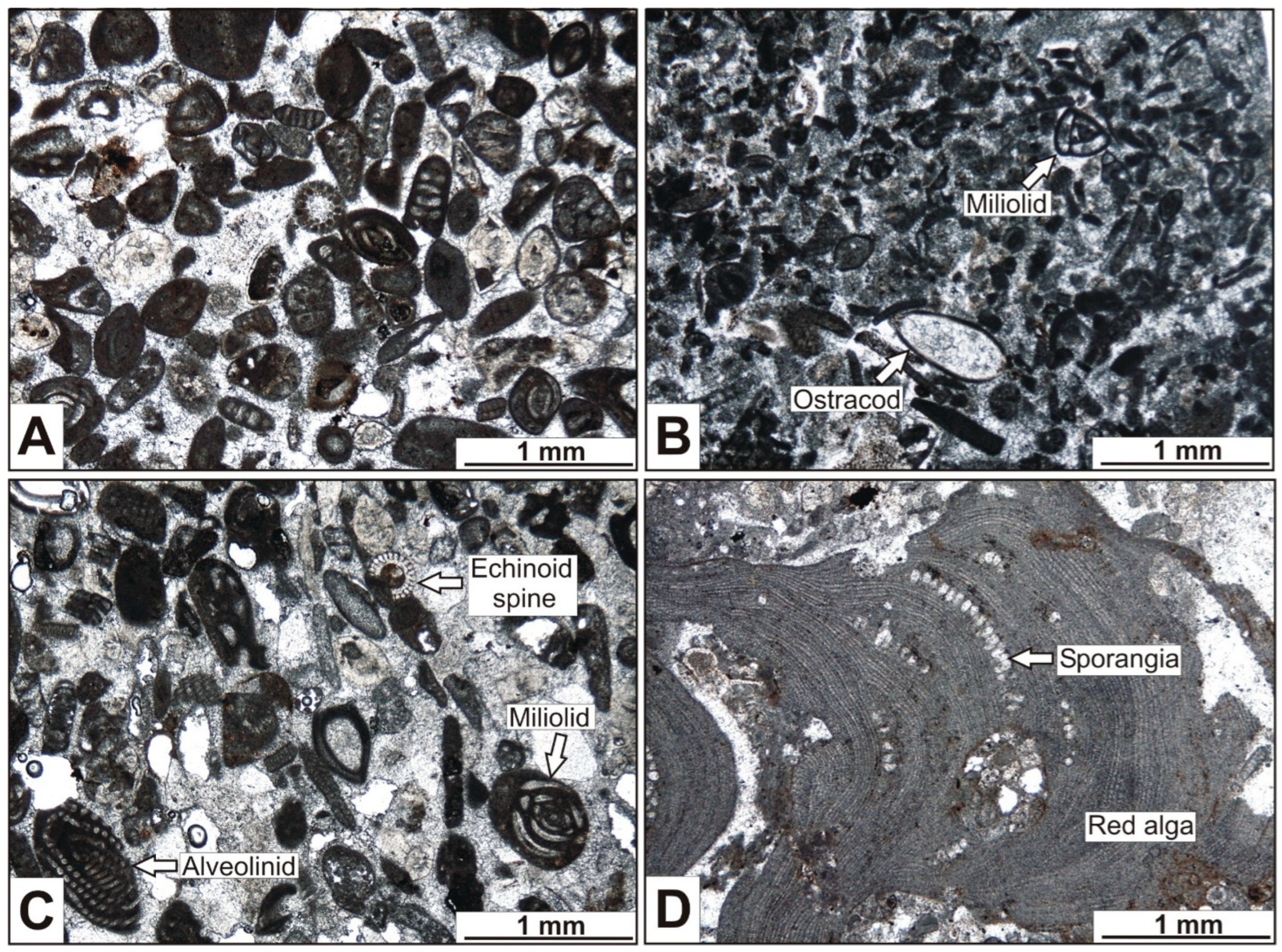

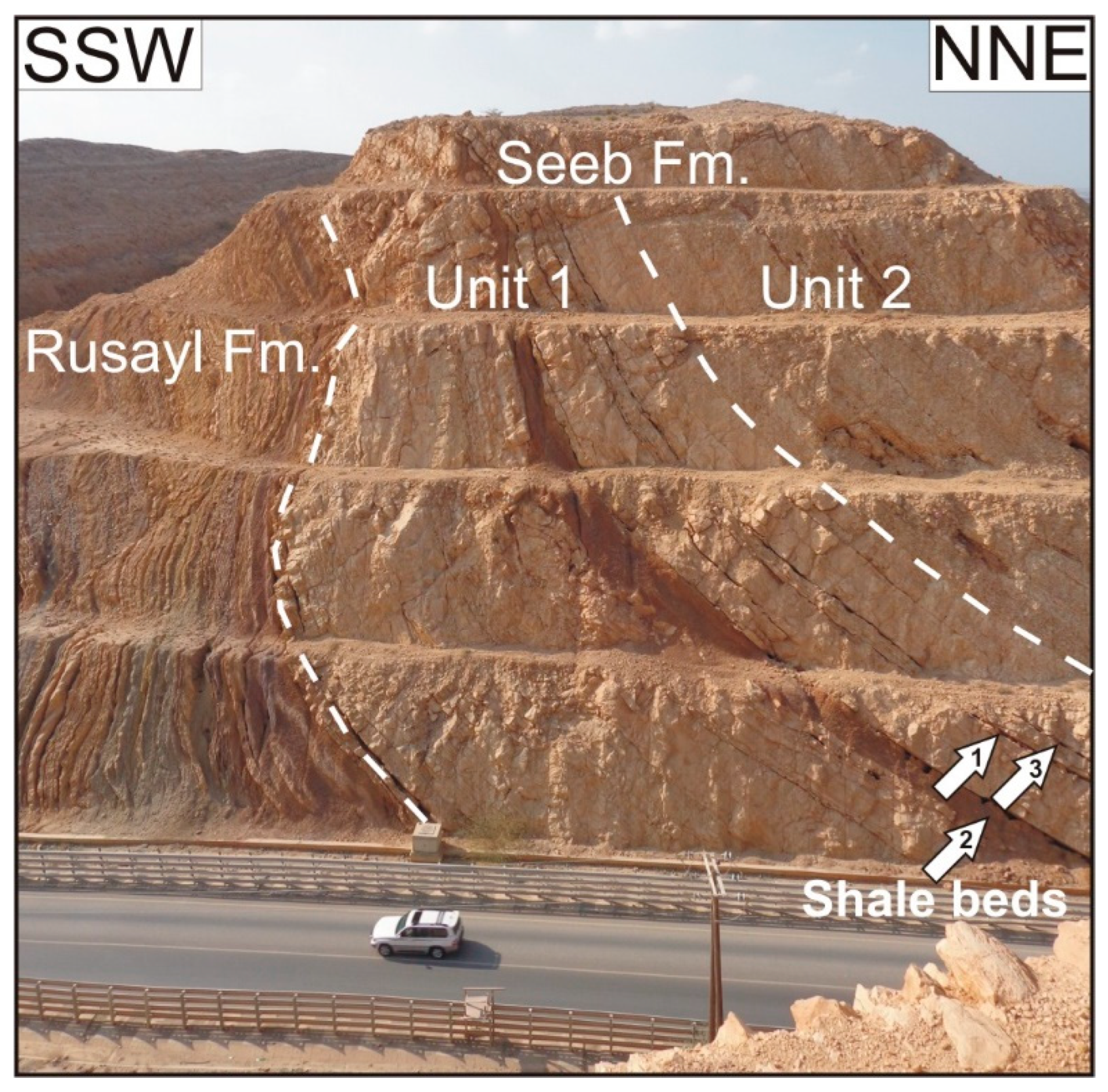
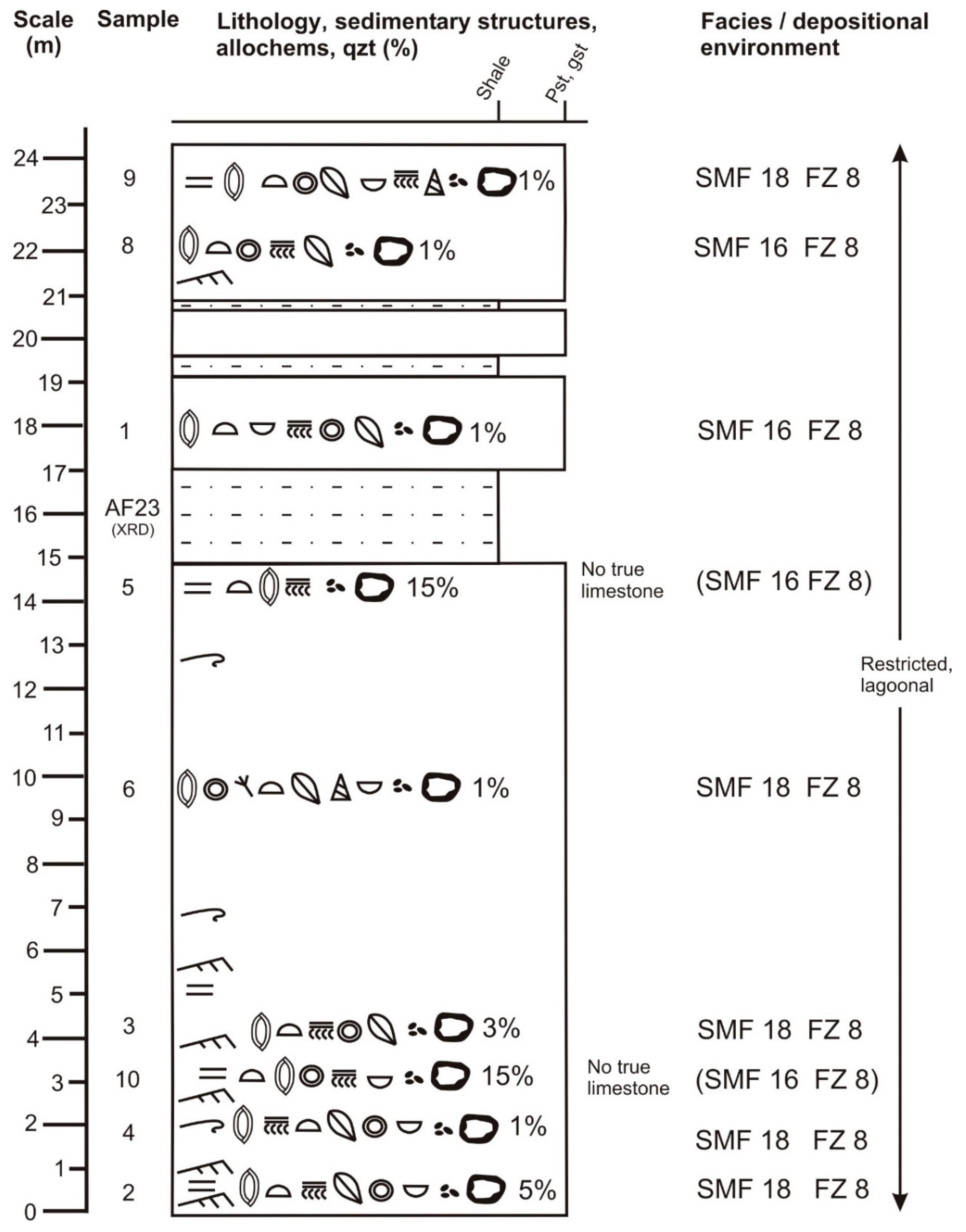
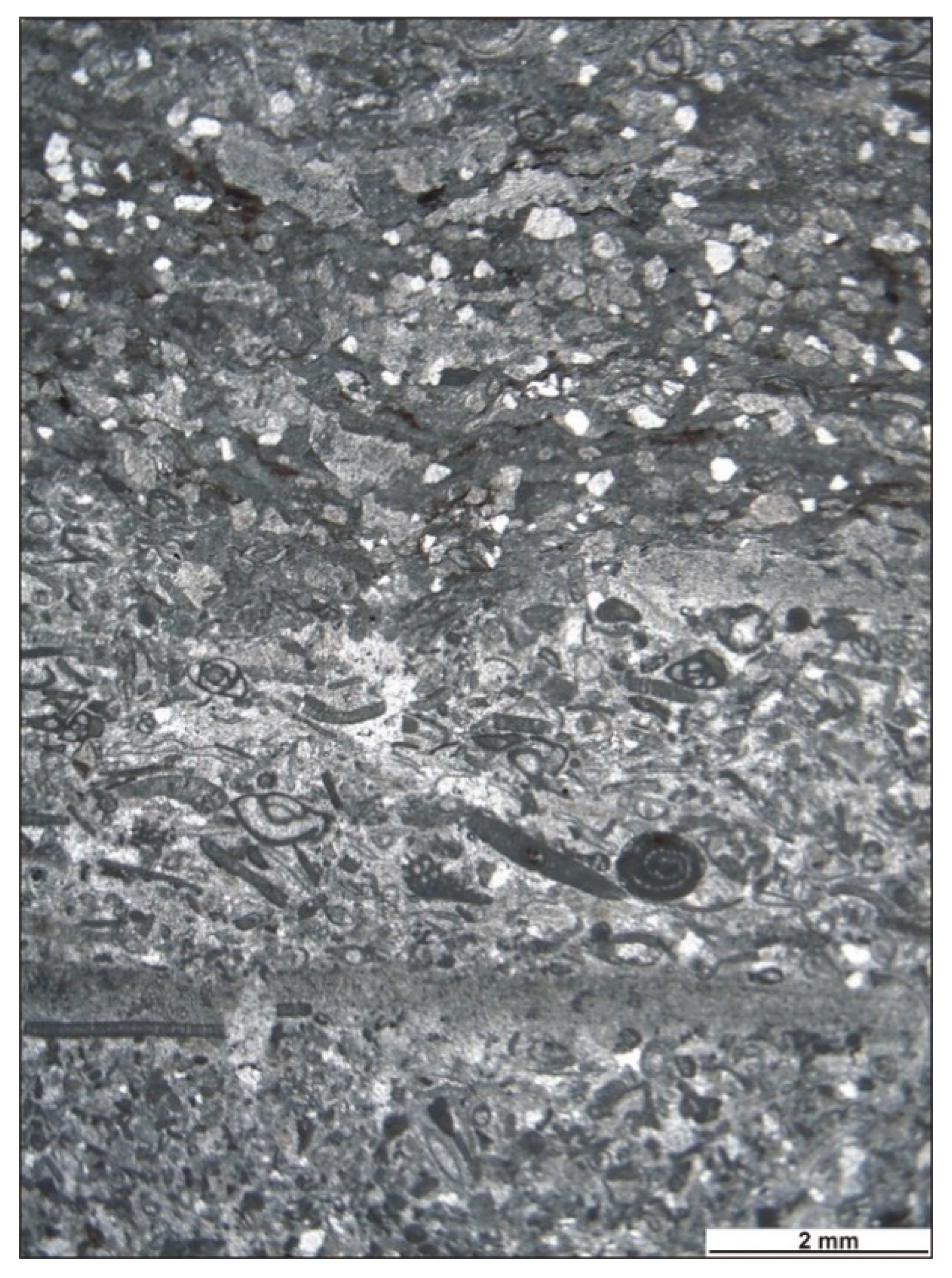
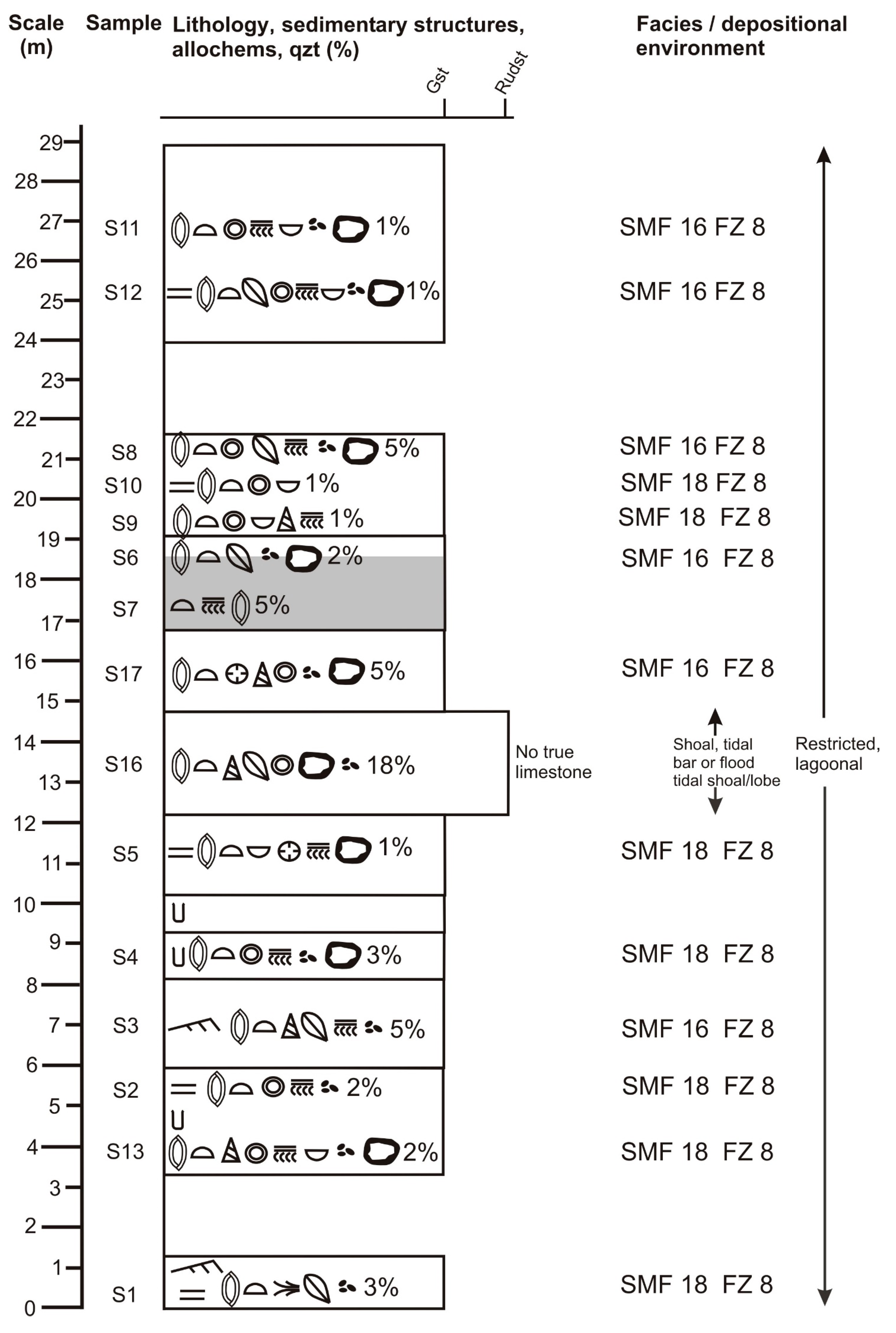
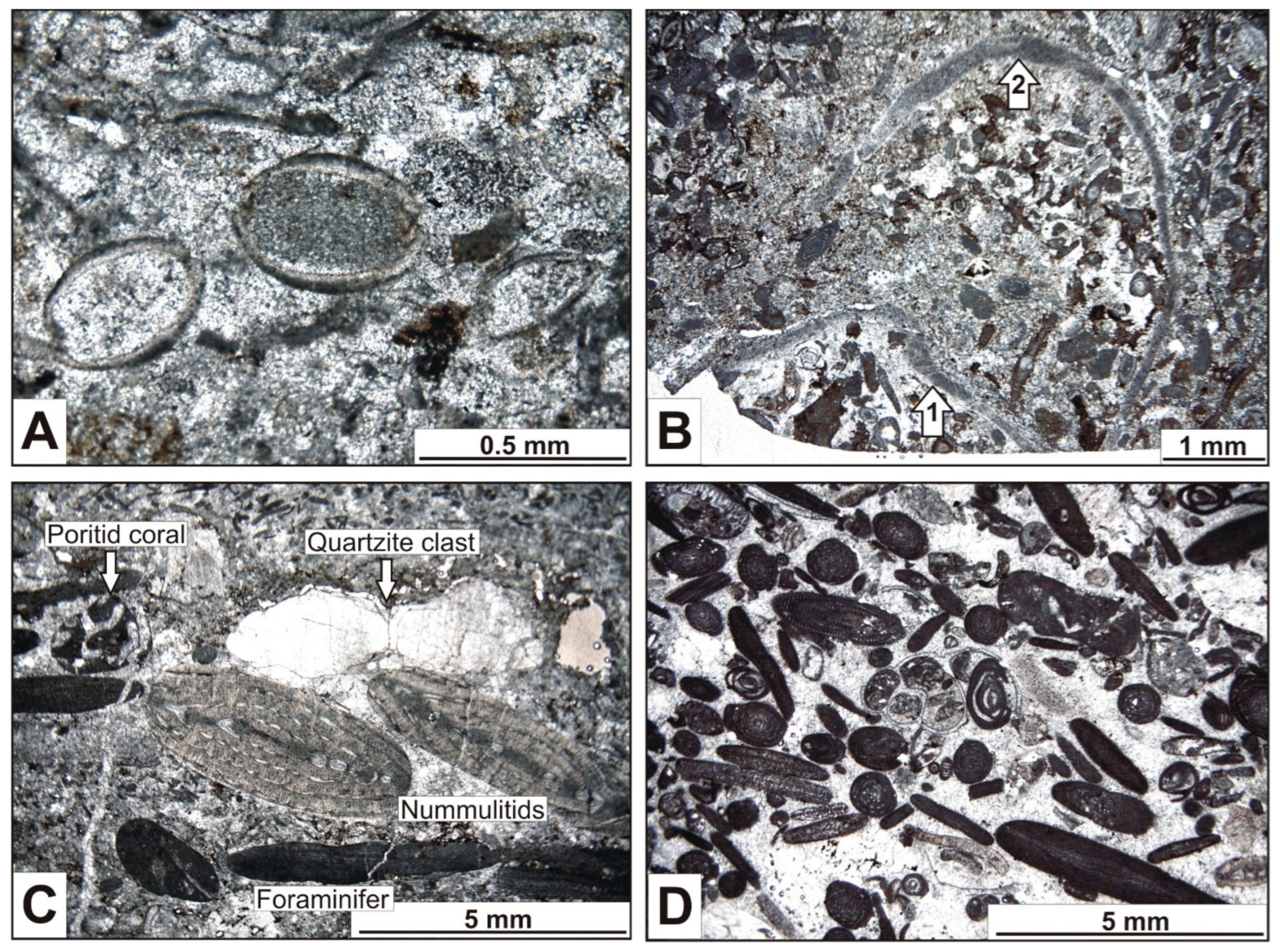
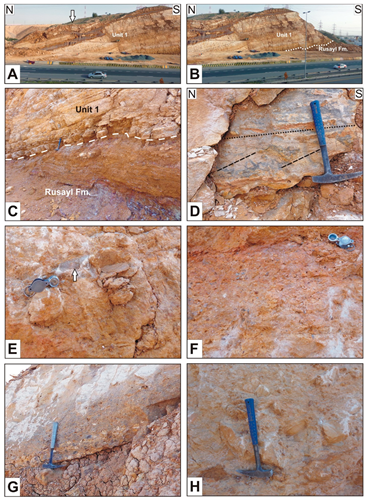
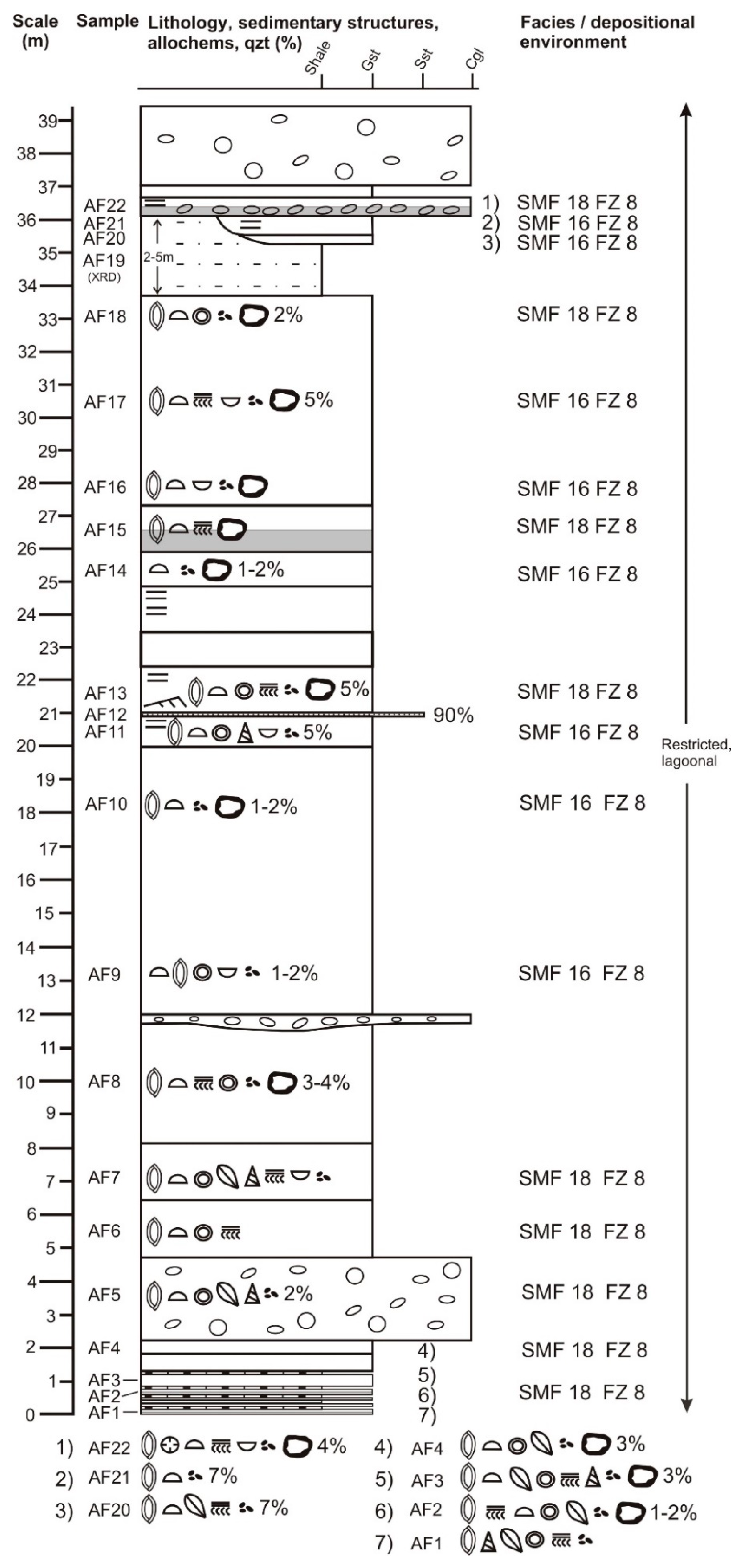
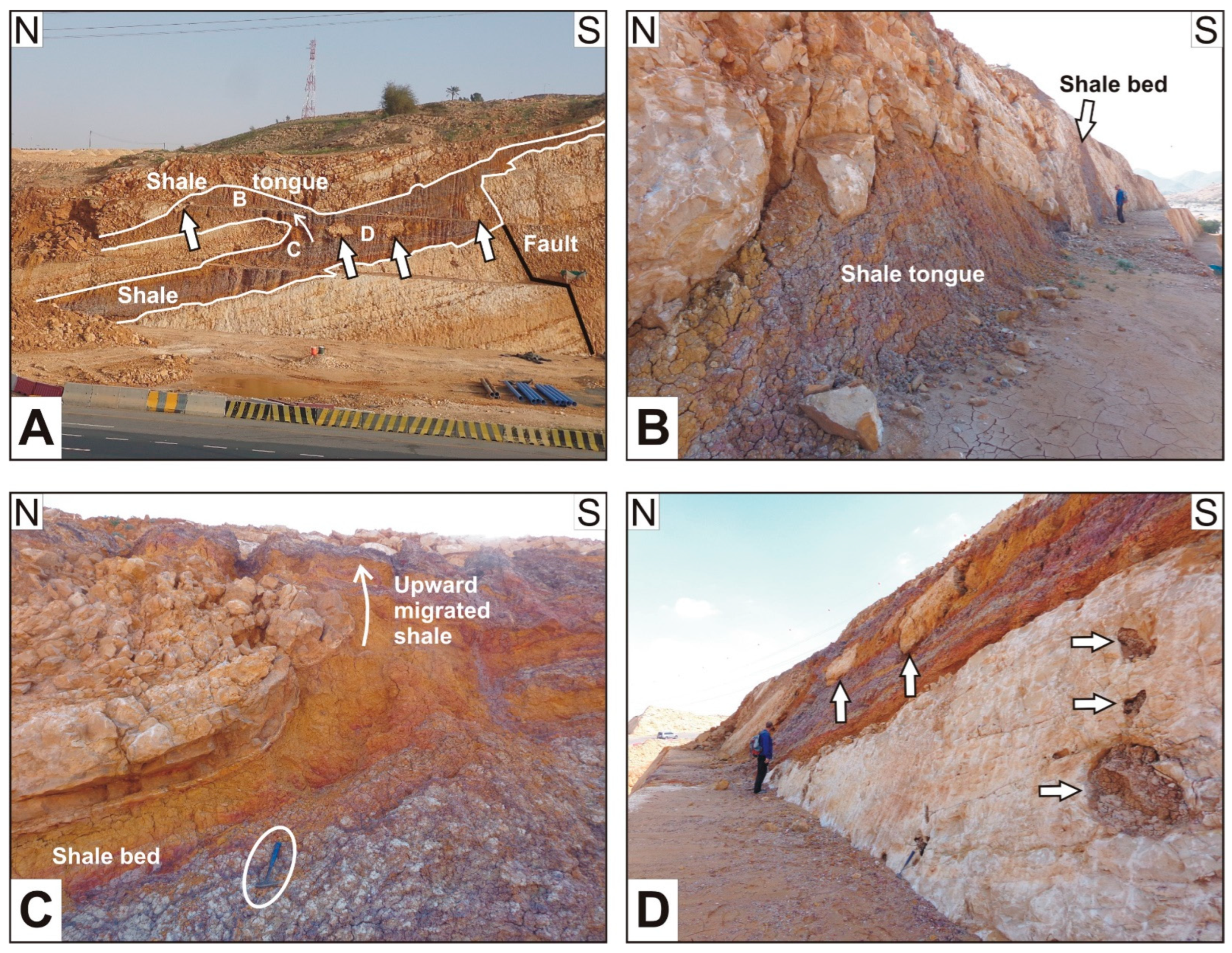
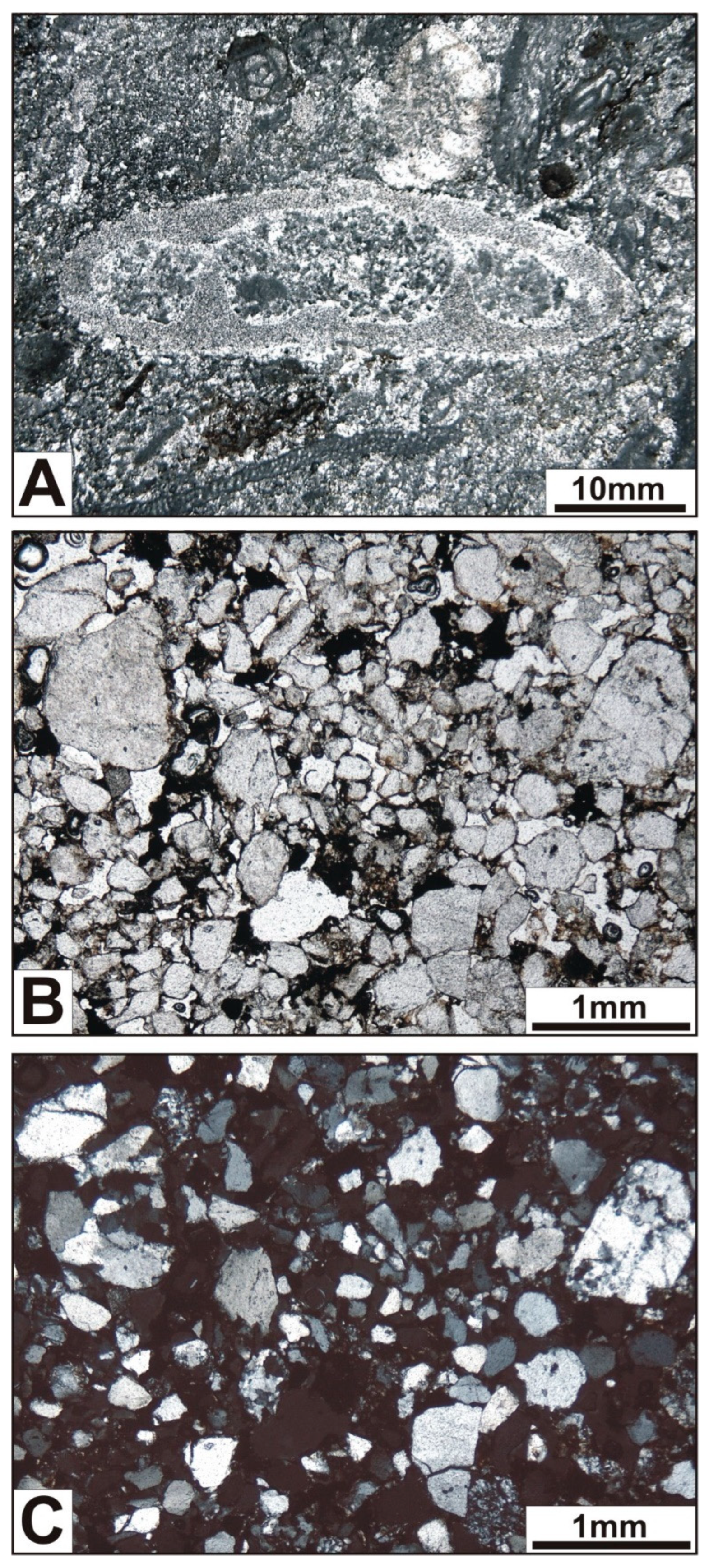
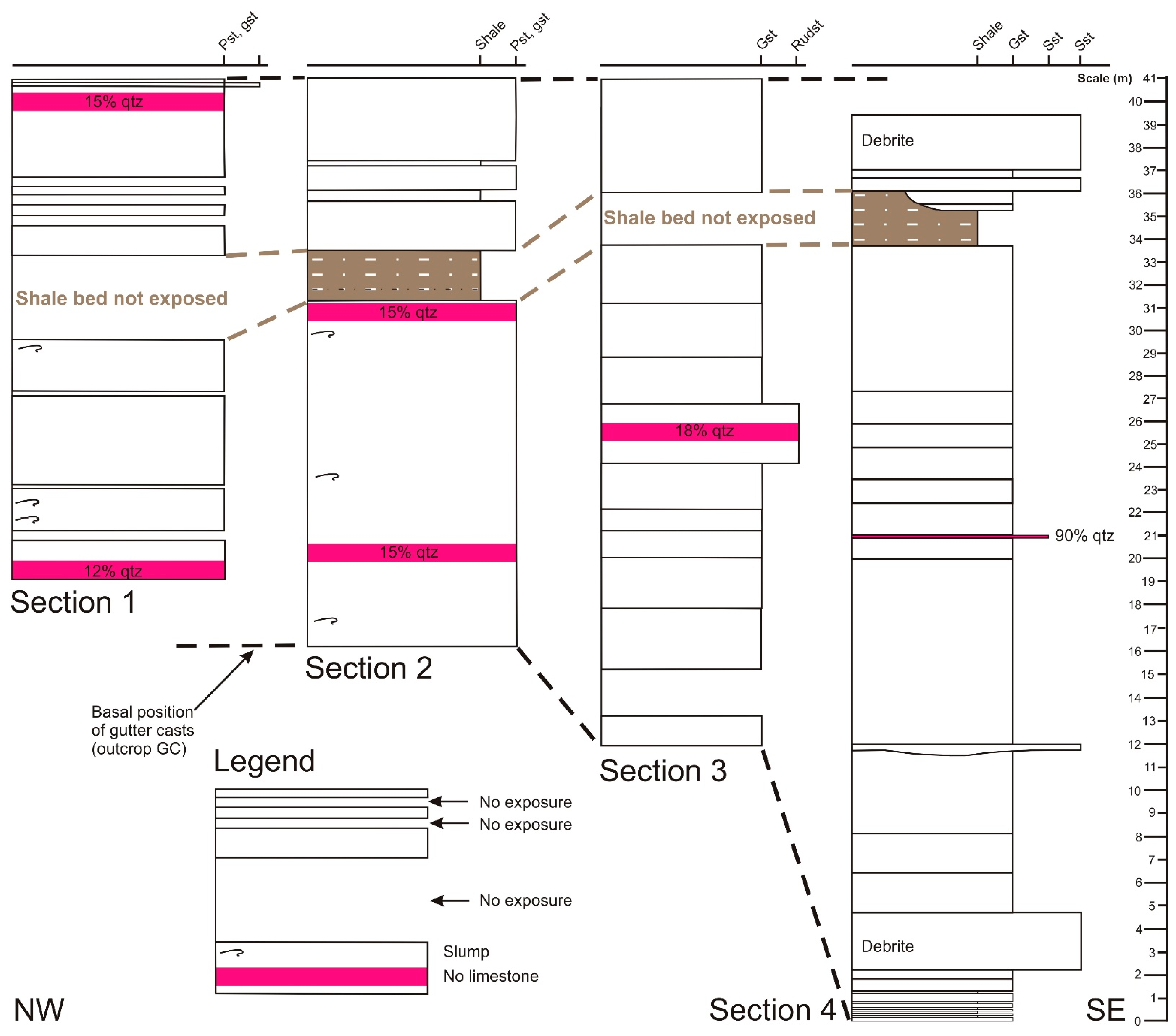
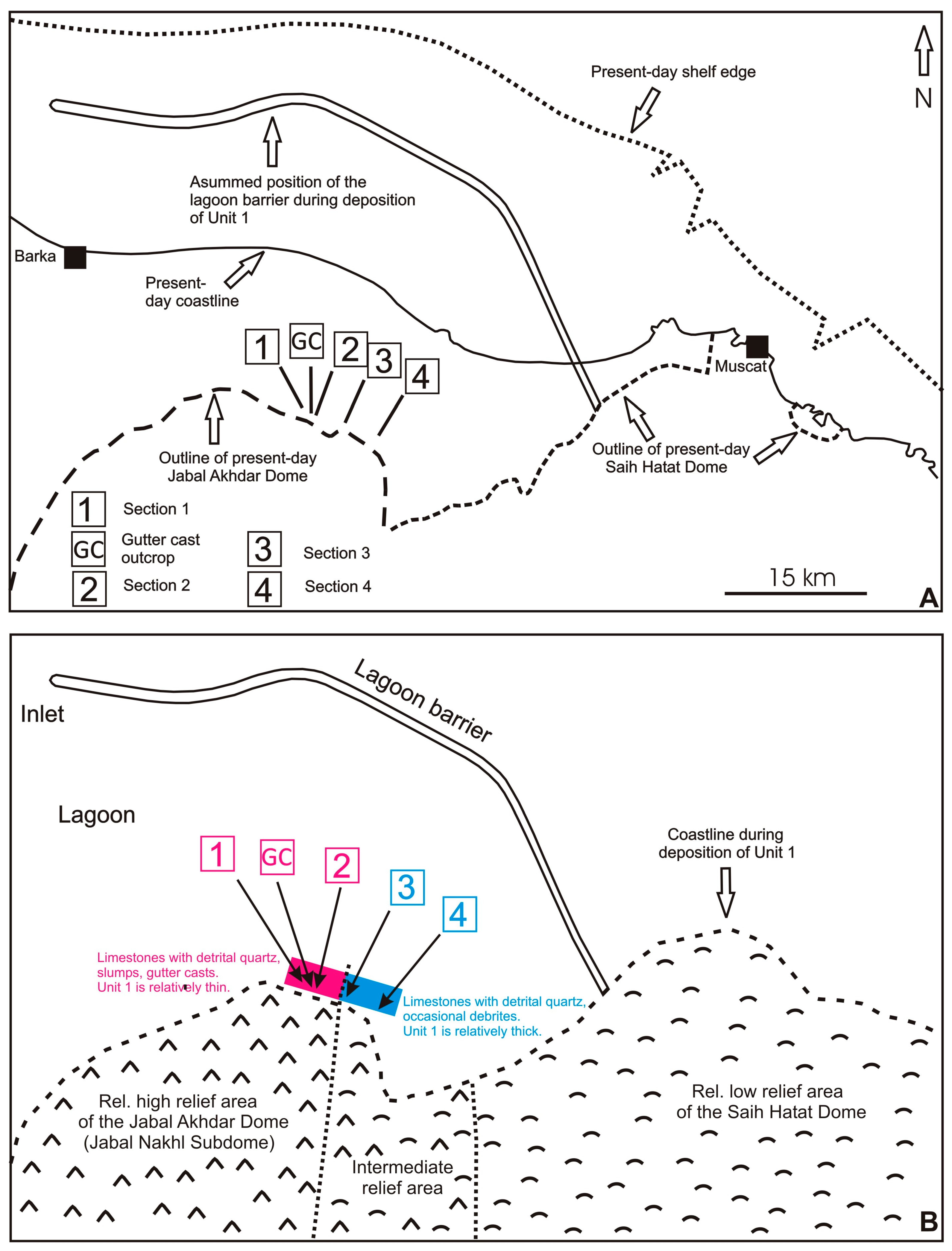
| Mineral | Formula | Wt% |
|---|---|---|
| A. Thickest shale bed of Section 2 (Seeb Formation, Sample AF23). | ||
| Quartz | SiO2 | 30 |
| Kaolinite | Al2Si2O5(OH)4 | 70 |
| B. Shale bed of Section 4 (Seeb Formation, Sample AF19). | ||
| Quartz | SiO2 | 30 |
| Gypsum | CaSO4·2H2O | 45 |
| Kaolinite | Al2Si2O5(OH)4 | 25 |
| C. Purplish shale bed from the top of the Rusayl Formation of Section 2 (Sample AF24). | ||
| Quartz | SiO2 | 40 |
| Kaolinite | Al2Si2O5(OH)4 | 60 |
| Section | Thickness |
|---|---|
| WSW | |
| Section 1 | >/~21.6 m |
| Section 2 | ~24.7 m |
| Section 3 | ~28.7 m |
| Section 4 | >39.5 m |
| ESE |
Disclaimer/Publisher’s Note: The statements, opinions and data contained in all publications are solely those of the individual author(s) and contributor(s) and not of MDPI and/or the editor(s). MDPI and/or the editor(s) disclaim responsibility for any injury to people or property resulting from any ideas, methods, instructions or products referred to in the content. |
© 2023 by the authors. Licensee MDPI, Basel, Switzerland. This article is an open access article distributed under the terms and conditions of the Creative Commons Attribution (CC BY) license (https://creativecommons.org/licenses/by/4.0/).
Share and Cite
Mattern, F.; Scharf, A.; Al-Sayigh, A.R.; Al-Wahaibi, N.; Galluccio, L.; Frijia, G.; Al-Salmani, M. Lagoonal Microfacies, Lithostratigraphy, Correlation and Shale Migration of the Basal Middle Eocene Seeb Formation (Rusayl Embayment, Sultanate of Oman). Geosciences 2023, 13, 254. https://doi.org/10.3390/geosciences13090254
Mattern F, Scharf A, Al-Sayigh AR, Al-Wahaibi N, Galluccio L, Frijia G, Al-Salmani M. Lagoonal Microfacies, Lithostratigraphy, Correlation and Shale Migration of the Basal Middle Eocene Seeb Formation (Rusayl Embayment, Sultanate of Oman). Geosciences. 2023; 13(9):254. https://doi.org/10.3390/geosciences13090254
Chicago/Turabian StyleMattern, Frank, Andreas Scharf, Abdul Razak Al-Sayigh, Nada Al-Wahaibi, Laura Galluccio, Gianluca Frijia, and Mazin Al-Salmani. 2023. "Lagoonal Microfacies, Lithostratigraphy, Correlation and Shale Migration of the Basal Middle Eocene Seeb Formation (Rusayl Embayment, Sultanate of Oman)" Geosciences 13, no. 9: 254. https://doi.org/10.3390/geosciences13090254
APA StyleMattern, F., Scharf, A., Al-Sayigh, A. R., Al-Wahaibi, N., Galluccio, L., Frijia, G., & Al-Salmani, M. (2023). Lagoonal Microfacies, Lithostratigraphy, Correlation and Shale Migration of the Basal Middle Eocene Seeb Formation (Rusayl Embayment, Sultanate of Oman). Geosciences, 13(9), 254. https://doi.org/10.3390/geosciences13090254








